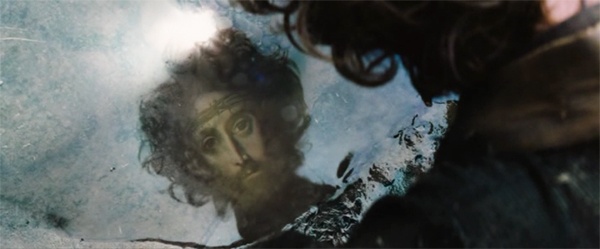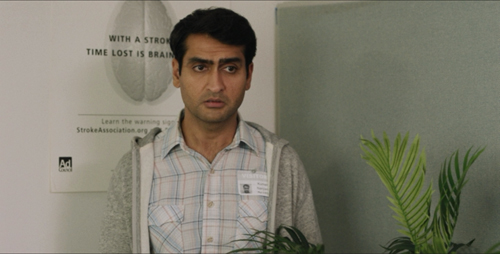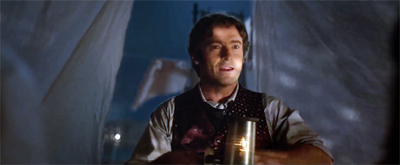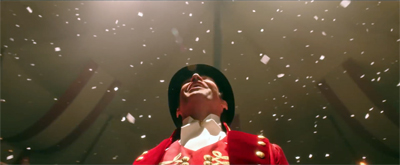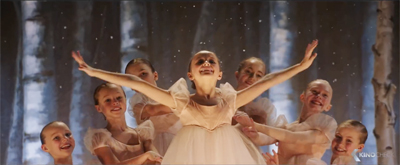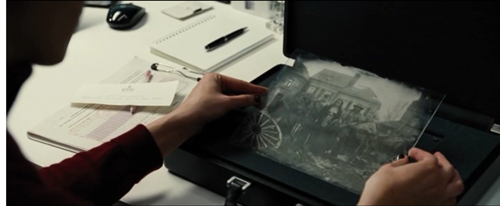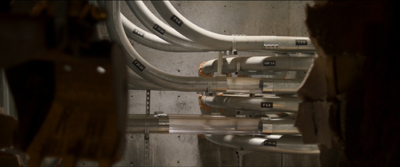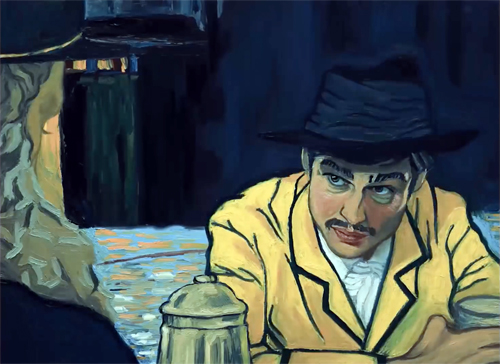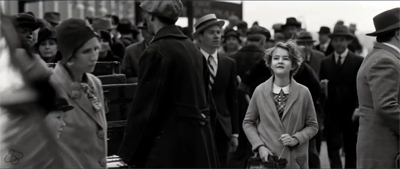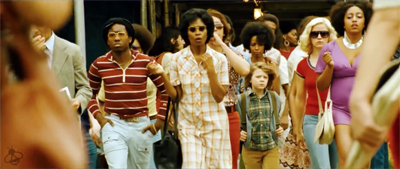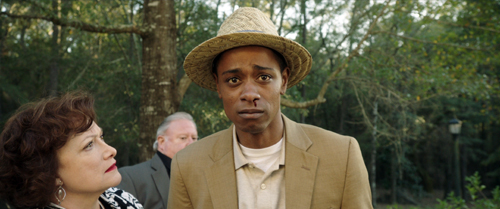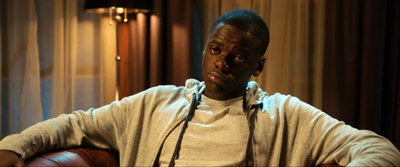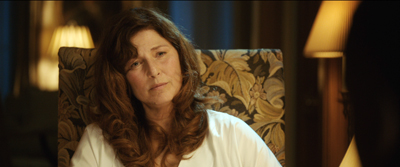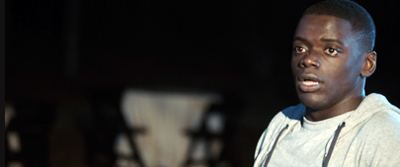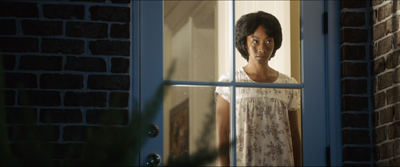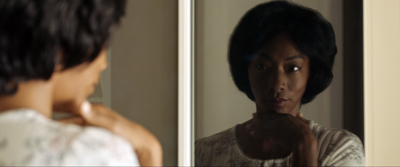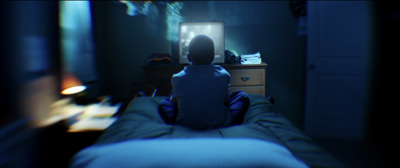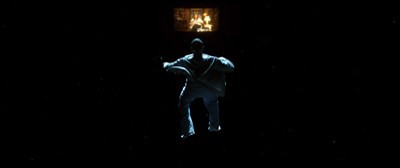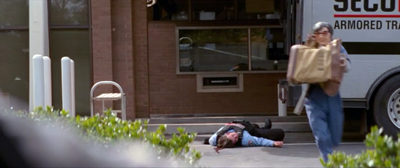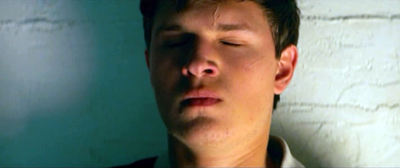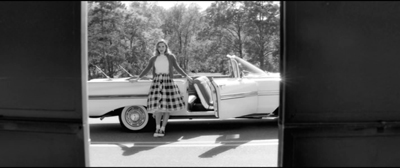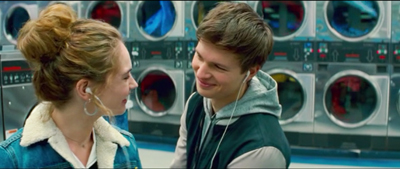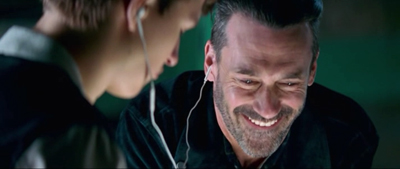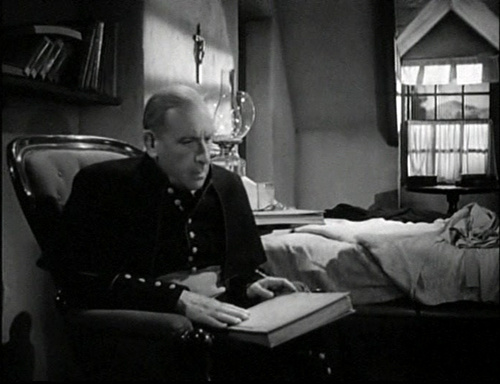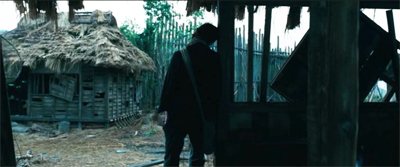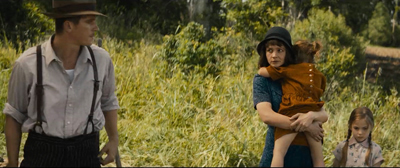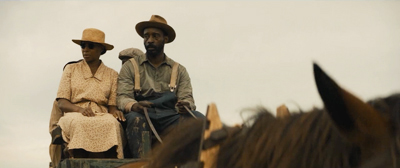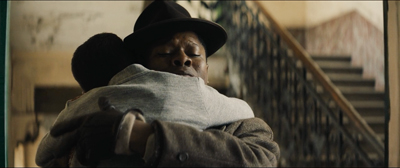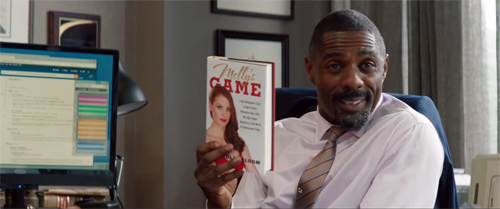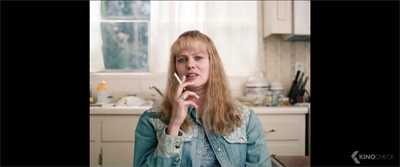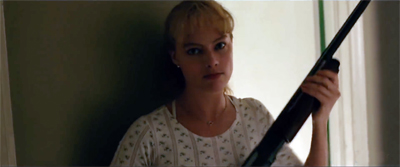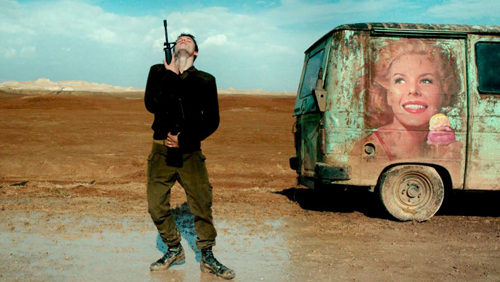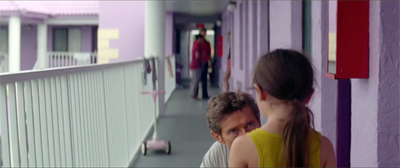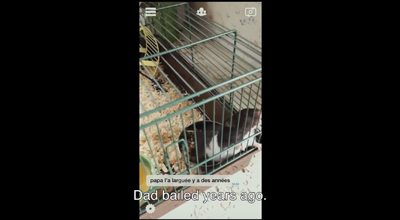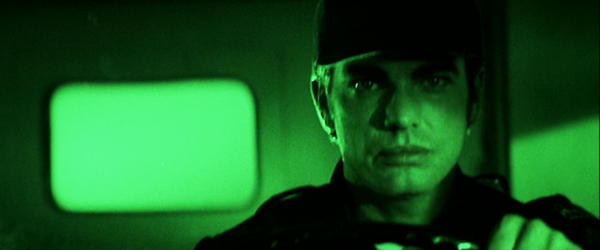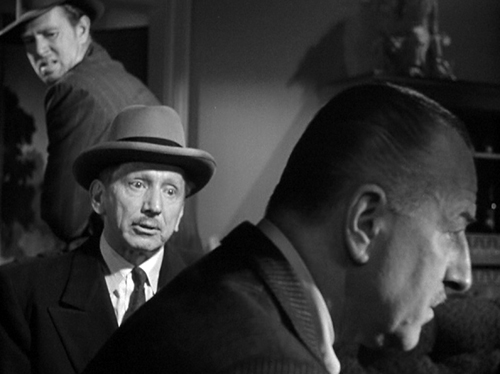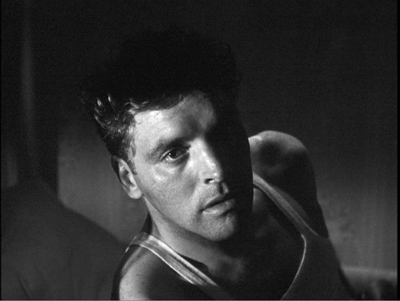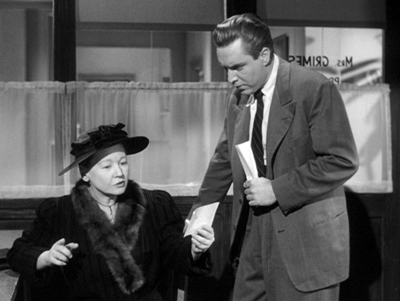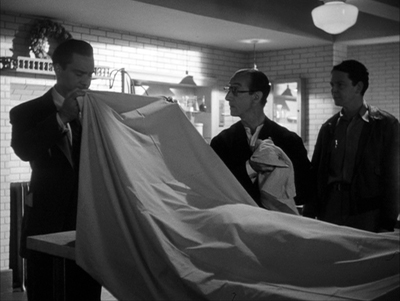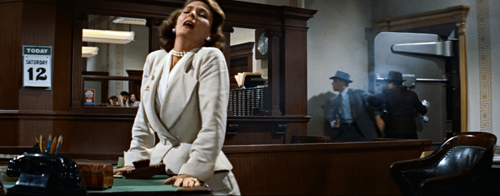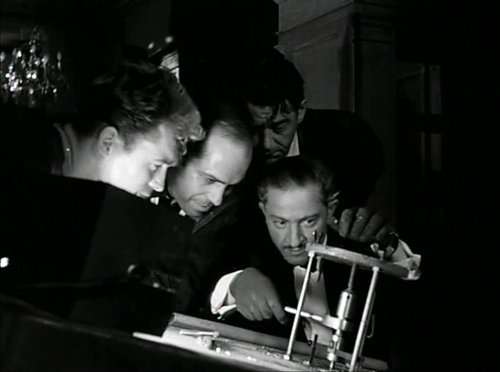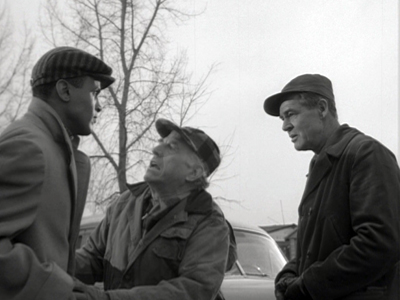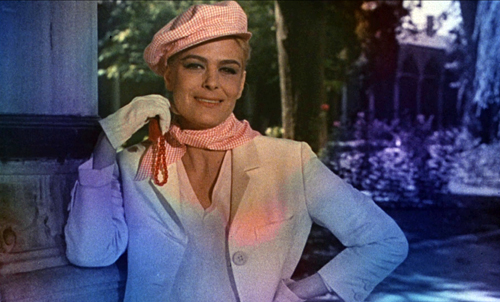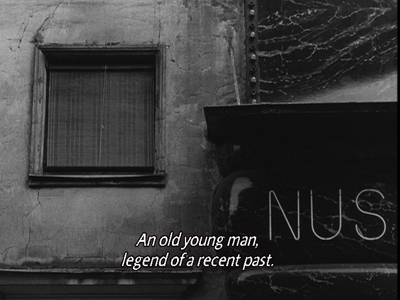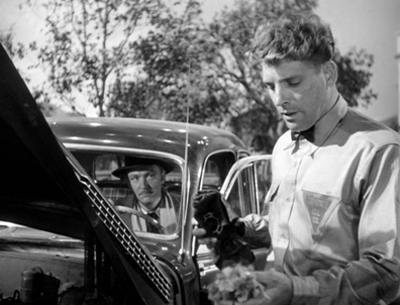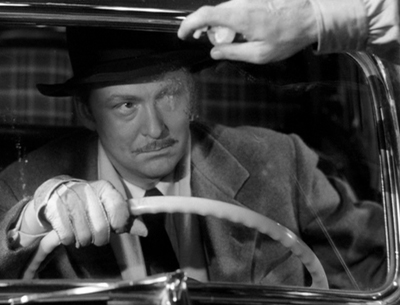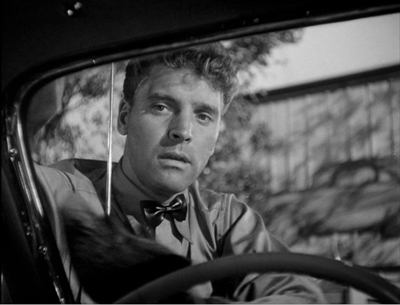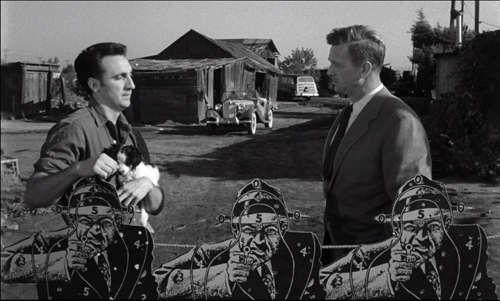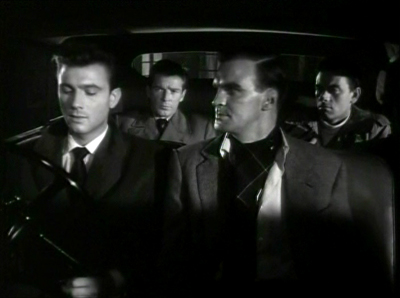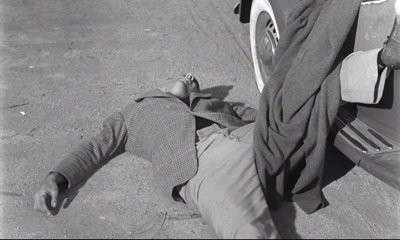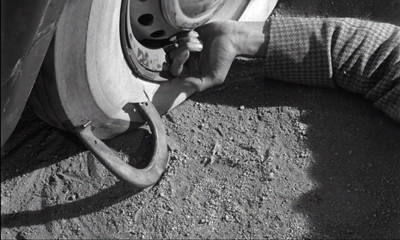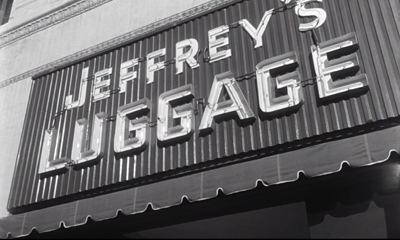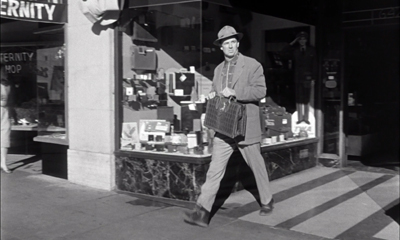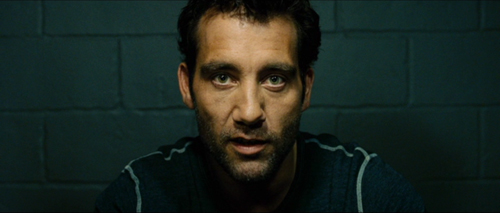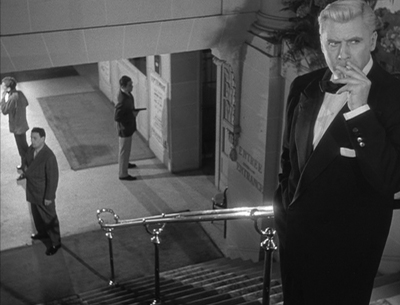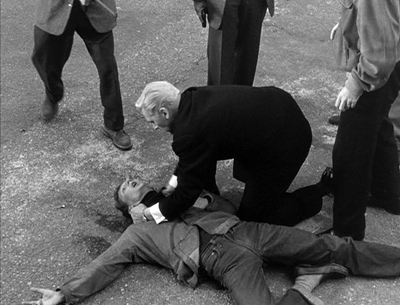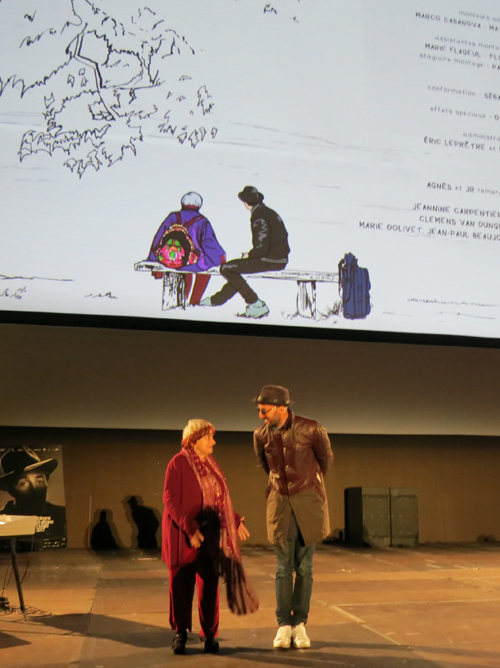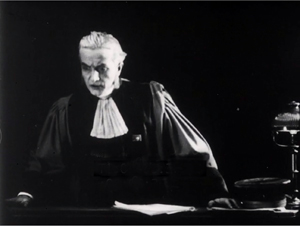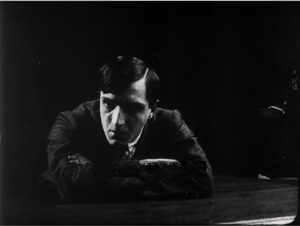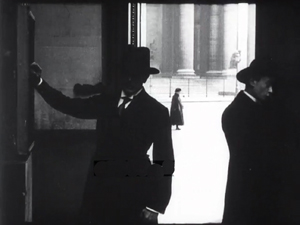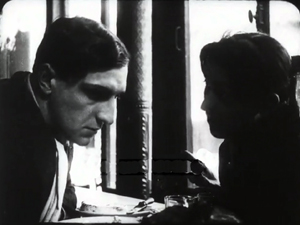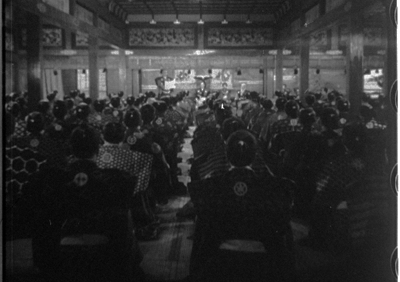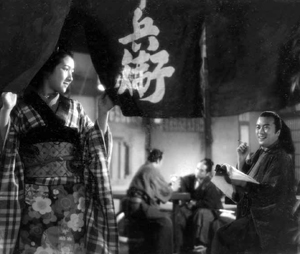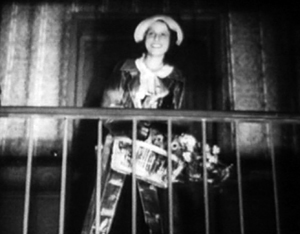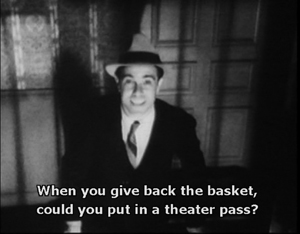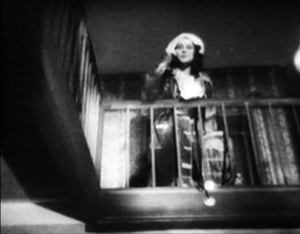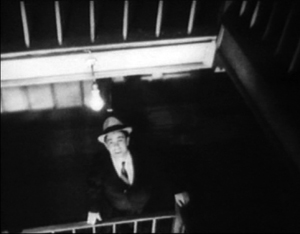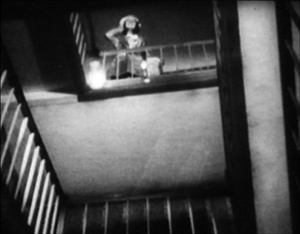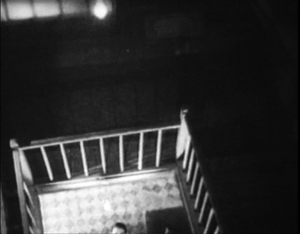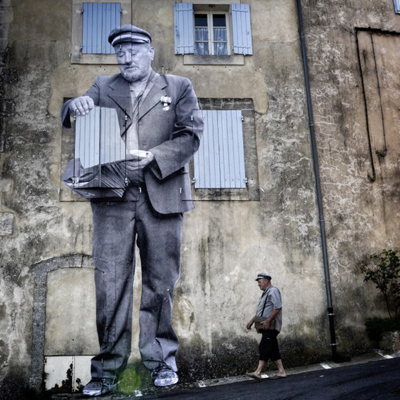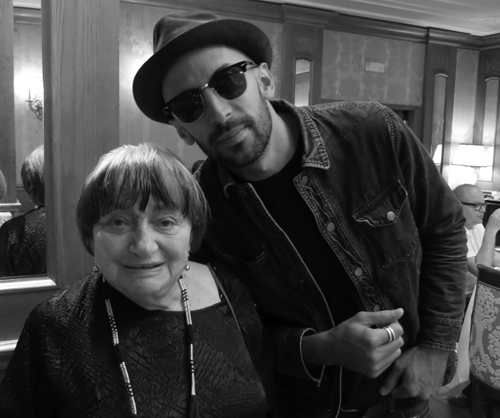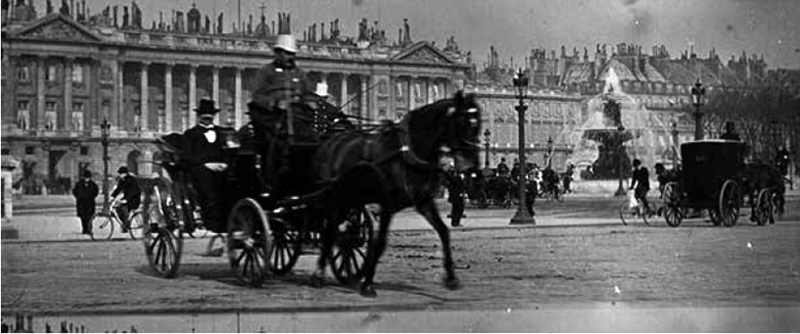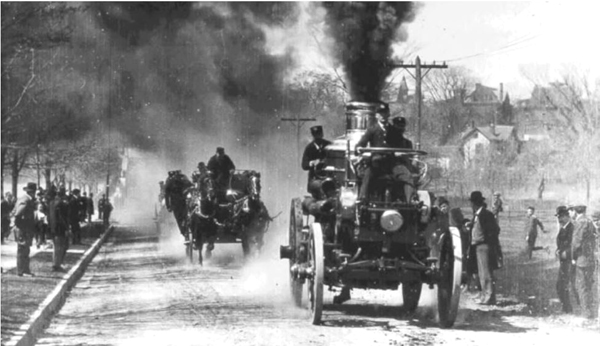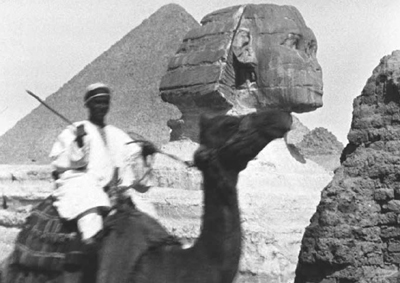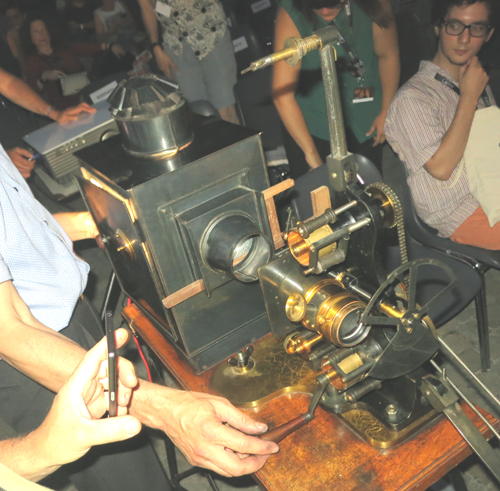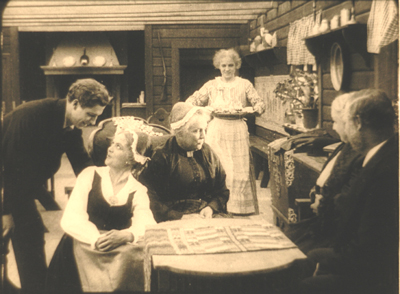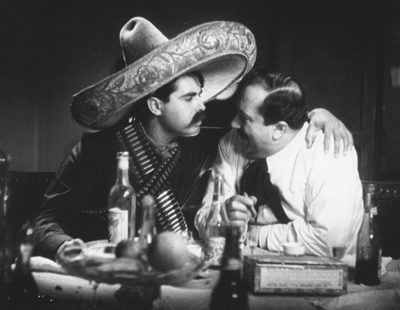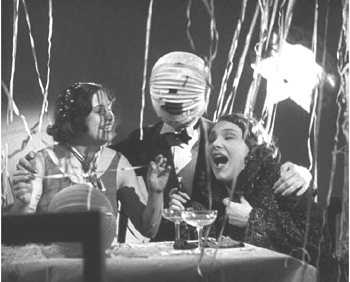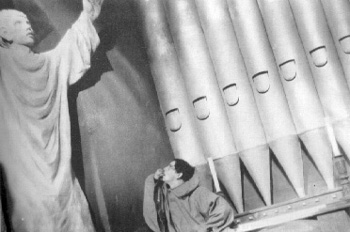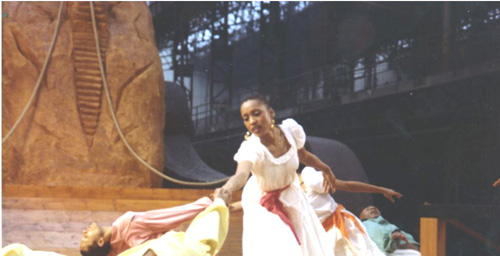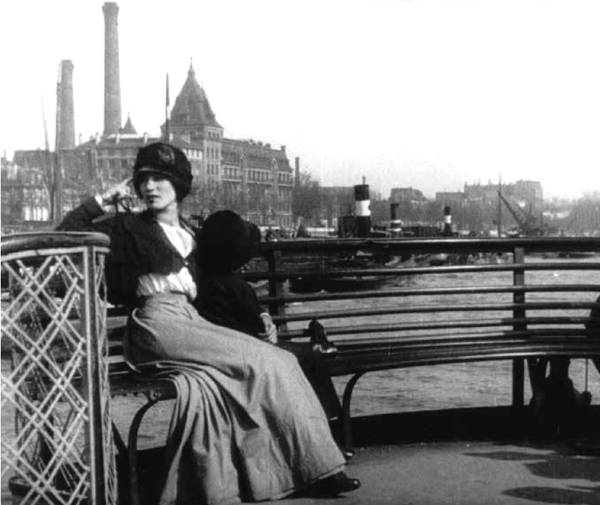Archive for the 'National cinemas: France' Category
Everything new is old again: Stories from 2017
Silence.
DB here:
This is a sequel to an entry posted a year ago. Like many sequels, it replays the ending of the original.
I don’t want to leave the impression that as I’m watching new release a little homunculus historian in my skull is busily plotting schema and revision, norm and variation. I get as soaked up in a movie as anybody, I think. But at moments during the screening, I do try to notice the film’s narrative strategies. Later, when I’m thinking about the movie and going over my notes (yes, I take notes), affinities strike me. By studying film history, most recently Hollywood in the 40s, I try to see continuities and changes in storytelling strategies. These make me appreciate how our filmmakers creatively rework conventions that have rich, surprising histories.
Parts of those histories are traced in the book that came out in the fall, Reinventing Hollywood. Some of my blog entries have already served to back up one point I tried to make there: that contemporary filmmakers are still relying on the storytelling techniques that crystallized in American studio films of the 1940s.
Relying on here means not only utilizing but also, sometimes, recasting. In keeping with earlier entries (including one from the year before last), I want to explore some films from 2017. These show that the process of schema and revision creates a tradition. Hollywood is constantly recycling, and sometimes revitalizing, Hollywood.
Of course here be spoilers.
Back to basics
The Big Sick.
The US films I’ll be considering all adhere to canons of classical Hollywood construction. Some of these are laid out in the third chapter of Reinventing.
Classically constructed films have goal-oriented protagonists who encounter obstacles, usually in the form of other characters. The goals are often double, involving both romantic fulfillment and achievement in some other sphere. (Somewhere Godard says that love and work are the only things that matter. Hollywood often thinks so too.) Alternatively, the goal might be prodding someone else to action (Three Billboards outside Ebbing, Missouri). Often there’s a clash between the goals, as when work tugs the protagonist away from love (La La Land).
The plot is typically laid out in large-scale parts. A setup is followed by a complicating action that redefines character goals. In Downsizing, once Paul has gotten small, he has to reconceive his goals in the face of his wife’s last-minute defection from their plan. There follows a development section that delays goal achievement through characterization episodes, backstory, subplots, parallels, setbacks, digressions, twists, and new obstacles. That marvelous slab of show-biz schmaltz, The Greatest Showman, relies for its development on a potential love triangle and a secondary couple’s romantic intrigue.
There follows a deadline-driven climax that resolves the action and an epilogue (sometimes called the tag) that celebrates the stable state achieved and perhaps wraps up a motif or two. The Greatest Showman presents Barnum’s success in creating a genuine circus and reconciling with his family. The tag shows a big production number, with the subplot resolved (Carlyle embracing Anne) and the motif of swirling points of light—initiated in Barnum’s spinning Dreams gadget—washing over the final spectacle and his daughter’s ballet performance.
Classical narration—what’s usually called point of view—typically attaches us to the main characters. But not absolutely: we’re usually given access to things they don’t know, mostly for the sake of arousing curiosity and suspense. And throughout, the film is bound together through recurring motifs that reveal character (and character change) or significant plot information. Think of the roles Guardians of the Galaxy Vol. 2 assigns to “Brandy, You’re a Fine Girl,” Pac-Man, David Hasselhoff, and that “unspoken thing.”
Or take The Big Sick, a semi-serious romantic comedy. Kumail’s initial goal is success in standup comedy, but he also falls in love with Emily. His Pakistani-American family constitutes the main antagonist, as his mother and father want him to go to law school and submit to an arranged marriage. He hasn’t told his family about Emily, which precipitates the couple’s big quarrel: “I can’t lose my family.” Kumail’s goal shifts when Emily is stricken by a mysterious disease. In the development section , as she lies in a coma, he gets to know her parents, and a tense sympathy develops between them. The crisis comes when Kumail confesses his true goals to his parents, they disown him, and Emily’s disease hits a life-threatening phase.
In the climax portion, Emily revives and breaks off with him, his parents grudgingly accept his move to New York, and he mounts a somewhat successful one-man show there. The film is tightly tied to Kumail’s range of knowledge, so we’re surprised when he is—as when Emily’s parents decide to move her to another hospital, and when Emily pops up in his New York audience, ready to reconcile with him.
The Big Sick exploits many comic motifs: the parade of would-be fiancées Kumail’s mother invites to dinner, the photos he keeps of them (which ignite Emily’s jealousy), the repeated sit-downs he has with his family, the dumb catchphrases deployed by other comics, and especially Emily’s “Woo-hoo!” heckling, which eventually attests to the rekindling of their love.
The power of classical plotting is shown in its ability to spotlight a Pakistani-American protagonist, an Islamic family demanding that a son adhere to tradition, and the pathos of parents facing the death of a daughter. But that ability to flexibly absorb new subjects and themes and emotional registers has kept the classical template going for about a century.
Time travel
Wonder Woman.
One of the hallmarks of Forties cinema, I argue in Reinventing’s second chapter, is a eagerness to explore what flashbacks can do. Flashbacks were already well-established, but a more pervasive acceptance of nonlinear storytelling, so familiar to us now, became firmly part of Hollywood sound cinema in this period.
One-off flashbacks are so common now we don’t particularly notice them. In The Big Sick, when Kumail visits Emily’s apartment with her parents, he peeks into her closet, and we get glimpses of her wearing the outfits earlier in the film. In this case, flashbacks function as memories. At the climax of Guardians 2, Quill flashes back to moments of listening to music with his mother. Similarly, in Get Out, Chris recalls his childhood TV viewing and, at the climax, he remembers earlier moments at the Armitage garden party when he asks, “Why black people?”
Flashbacks usually aren’t pure representations of memory, though. They often include information that the character doesn’t or couldn’t know. In fact many flashbacks are addressed simply to us, coming “from the film” rather than from a character’s mind. These may remind us of things already seen, or fill in gaps, or plant hints about things that will develop.
So, for instance, in Logan Lucky, when Logan says, “I know how to move the money,” we get a flashback to him studying the pneumatic pipes that feature in the heist plan.
He’s not necessarily recalling the moment; the filmic narration seems merely to be tipping us the wink. At the climax, other “external” flashbacks plug gaps we didn’t notice earlier. These reveal some aspects of the heist we weren’t aware of, such as the extra bags of money carried off.
1940s filmmakers also explored how flashbacks could be “architectonic,” how they could inform the overall shape of the movie. Here the flashback rearranges story order to build up curiosity and suspense, and it may come from purely from the narration or be motivated as character memory.
One large-scale pattern is the extensive embedded flashback, as in How Green Was My Valley, I Remember Mama, and innumerable biopics. Wonder Woman gives us a framed inset of this sort, when a modern-day Diana opens the chest harboring the World War I photo. That scene segues to the past. The origin story and war episodes are ultimately closed off by a return to the present, and a reminder of a motif—Steve’s watch (which, in one of the film’s jokes, stands in for something more private). The purpose of this is to provide what I call in the book “hindsight bias.” While building curiosity about the past, the opening primes us to expect certain things to have been inevitable (such as chance meetings).
Another common framing strategy begins at the climax and then a long flashback lays out the conditions that led up to it. A reliable source tells me that Pitch Perfect 3 does this, starting with an explosion followed by a title announcing that the action began three weeks earlier. In films like this, there may be no closing frame; the internal action of the flashback catches up, perhaps via a replay, with what we saw at the outset, and the film proceeds to the resolution and epilogue. The somewhat phantasmic opening number of The Greatest Showman comes to fruition during the finale.
To and fro
Loving Vincent.
Sustained blocks like this are fairly rare nowadays, I think. More common, as in the Forties, is an alternation of past and present. The main examples in Reinventing Hollywood include Passage to Marseille, The Locket, Lydia, Kitty Foyle, and Sorry, Wrong Number. Again, though, these are motivated as memories, while current examples tend to be more “objective.”
A simple instance is Film Stars Don’t Die in Liverpool. Here clusters of events in 1981 alternate with incidents in 1979: Gloria Grahame returns to her young lover, and we flash back to their earlier affair. Neither protagonist is firmly established as recalling the 1919 events. Another feature of 1940s flashbacks, the replay from different viewpoints, comes in here as well. The couple’s crucial quarrel in New York is shown first from Peter’s perspective, and later from Gloria’s. He suspects her of infidelity, but we learn that her secret involves her cancer. As often happens, our restriction to the protagonist is modified by knowledge he doesn’t gain at the moment.
The alternation of past and present is given a more geometrical neatness in Wonderstruck. In maniacally precise parallels, Rose in 1927 runs away to Manhattan to find her mother, while in 1977 Ben runs there to find his father.
The parallels are reinforced by a host of motifs: wolves, movie references, the asteroid in the Museum of Natural History, a bookmark, and so on. The linear chronology gets straightened out, and the gaps filled, by an integrative flashback played out among miniatures and cutouts adapted to the scale model of Manhattan. The dovetailing flashbacks create a sense of cosmic design; in many films, convergences like these can suggest destiny.
For modern audiences, Citizen Kane is the prototypical flashback film of the 1940s, and its investigation structure, while not completely original, was hugely influential. I was surprised to see Kane’s schema revived this year in Loving Vincent. Once the postman has given Armand his mission, to take Vincent’s last letter to brother Theo, we embark on an inquiry into Vincent’s life and death. It’s refracted through the testimony of many who knew him during his sojourn in Arles. Armand’s goal gets recast when he learns of Theo’s death, but in the course of his travels he comes to understand how Vincent’s kindness and art touched many lives.
As in several Forties films, Loving Vincent’s past scenes jumbled out of chronological order, so we must piece together the story Armand gradually discloses. And there’s the driving force of mystery, a distinctive thrust in many Forties genres, for reasons I talk about in one chapter of Reinventing. Very modern, and not so much like the 1940s, is the brief, fragmentary quality of the flashbacks; I counted thirty-six of them.
The boldest experiment in nonlinear time I saw this year was Dunkirk. The film juxtaposes timelines consuming a week or so, a day, and an hour, and then aligns them in unexpected ways. In this staggered array, the distinction between flashbacks and flashforwards loses its force. Any cut may constitute a jump ahead of the moment just shown, or a jump back to an earlier incident. Christopher Nolan has acknowledged the influence of 1940s cinema on his thinking about time schemes, and here he explores yet again how crosscutting different lines of action can stretch or condense story duration.
Their eyes and ears
Get Out.
Like flashbacks, subjectively tinted storytelling has a long cinematic lineage. Silent films displayed dreams, visions, anticipations, and deformations of mind and eye. Those devices mostly dropped out of 1930s American cinema, which was to some extent more “objective” and “theatrical” in its mode of presentation. Subjectivity came roaring back in the Forties, which is why Reinventing Hollywood devotes two chapters and several other passages to various techniques that go beneath the surface.
Memory-based flashbacks are common options today, but the inward plunge can take other forms. For most of its length, Get Out restricts us to Chris’s range of knowledge, and it relies on optical POV in many stretches. Through his eyes we see Mrs. Armitage staring at him while stirring the tea.
More complex is his view of Georgina at the upper window. That’s followed by a shot going beyond his range of knowledge: she’s looking not at him but herself.
We take a deeper dive into Chris’s mind under hypnosis. The boy Chris sinks into a stellar cavity and becomes Chris staring at Mrs. Armitage as if she were appearing on the TV screen. The shift dramatizes his guilt at his mother’s death and his susceptibility to this Bad Mom figure.
Once Chris becomes a prisoner, the narrational range widens again to show Rod’s efforts to rescue him, along with the family’s plans for him. But the film tightly realigns us with Chris at the climax, so that the attacks from Rose, Jeremy, and others come as surprises.
Chris, a photographer, channels his experience through vision, though the hypnotism scene blends sounds from the present with the rain drizzling in the past. Subjectivity goes more fully sonic in Baby Driver, about a whey-faced lad who lives in the auditory ether.
Edgar Wright, now exercising straight the percussive dashboard details he parodied in Hot Fuzz, punches up the visual exhilaration of Baby’s rubber-shredding takeoffs and getaway 180s. He locks us into Baby’s auditory world as well. We’re almost completely attached to Baby, learning what he learns when he learns it. Notably, the robberies are rendered from his perspective, including optical POV shots as he waits in the getaway car.
Again, fragmentary flashbacks replay his mother’s death and the childhood damage to his hearing. We even get a fantasy, with Baby imagining his escape with Debora in black and white.
What’s just as subjective, though, is the music Baby incessantly cues up on his iPod. Blocking out the shriek of his tinnitus, it provides a soundtrack to his life—danceable tunes as he bops down the street, ballads when he flirts and falls in love with Debora, and pulsing rock during robberies (what the psycho Bats calls, “a score for a score”). Through volume and texture, Wright suggests that we hear the music as Baby does; only the loudest environmental sounds poke through. Sometimes, when he pulls out one earbud, the volume drops. His growing attachment to Debora is signaled by his dialing up a song using her name and sharing his precious buds.
Some scenes are handled objectively, as we witness the gang’s conversations in front of Baby. He can read lips, though, and he can keep the iPod cranked up. So a little bit of Baby’s custom soundtrack leaks in for us underneath others’ dialogue. At other times, the score takes over to become nondiegetic accompaniment, as when gunshots in a firefight land on the off-beats of “Tequila.”
As you’d expect, the music comments on the action throughout (“Never ever gonna give you up” when Baby defends Debora from Buddy) and supplies motifs. Queen’s “Brighton Rock,” Baby’s favorite heist accompaniment, briefly enables him to bond with Buddy.
A song about a couple’s devotion reminds us that both thieves are loyal to their women.
Momentary sound changes are rendered through our protagonist’s viewpoint. Wright lets us hear the whine of Baby’s tinnitus as Bats taps his ear. When Buddy blasts his pistols alongside Baby’s head, we suffer his hearing loss and the distorted voices that wobble through it.
Such streams of auditory perception occasionally emerged in early talkies (e.g., Gance’s Beethoven). Those experiments got normalized in 1940s manipulations of sound perspective in different environments. More fancily, in A Double Life (1947), party chatter subsides when the hero covers his ears, and in Pickup (1951), the gradually deafening protagonist hears high-pitched noises. Wright extends these one-off devices to the texture of an entire film.
Confidants
The Keys of the Kingdom (1945).
Large-scale and small-scale, the heritage of the 1940s seems to be everywhere. Many of the flashbacks and fantasies I mentioned already are primed by a track-in to a character’s face, just as in classic studio pictures. There’s also block construction, either unsignaled as in the Wonder Woman and Greatest Showman cases, or signaled, as in the date-stamping in the early alternations of Film Stars Don’t Die in Liverpool. We also get explicit chaptering, as in The Meyerowitz Stories (New and Selected) and Norman: The Moderate Rise and Tragic Fall of a New York Fixer.
Voice-overs come along with flashbacks, as a way of guiding the audience to understand the time shifts. In the Forties, as I discuss in the book’s sixth chapter, voice-overs became more flexible and fluid. Sometimes they were external, issued from an all-knowing commentator (Naked City and other police procedurals). Sometimes they were sonic equivalents for letters and diaries, letting us in on what characters were writing. Deeper intimacy could come from voice-overs serving as inner monologues, the voice of a character’s mind. These, like flashbacks, are associated with film noir, but also like flashbacks they actually emerge in many genres–as they do today.
The voice-over can be perfunctory, as in All the Money in the World. Young Paul Getty, kidnapped in the opening reel, has a couple passages confiding in us, but he’s not heard from again. Moreover, his explanation of his grandfather’s rise to power (during the inevitable flashbacks) could have been supplied in other ways. Paul baldly tells us that we need to know all this to understand what follows (who’s he talking to?). He admits that he’s an expository shortcut. This is why voice-over is sometimes considered lazy storytelling.
It doesn’t have to be. Take Martin Scorsese’s Silence. In subject and strategy it reminded me of The Keys of the Kingdom (1945), which dramatizes the diary of a young missionary to China. Via this novelistic device, we get flashbacks to his youth and his years of service. We get as well the reaction of the skeptical priest whose voice reads the journal. This fairly straightforward schema is in effect revised by Scorsese and co-screenwriter Jay Cocks, who create a floating dialogue among voice-overs.
After initial exposition via an old letter from Father Ferreira, which is recited in his voice, two young priests set out for Japan. They hope to maintain the clandestine Christian community there, and they want as well to discover if Ferreira has truly renounced his faith . The bulk of their grim adventures is commented on through the voice-over of one of them, Father Sebastião Rodrigues. At first he’s vocalizing a letter, which he calls a report, summing up the struggles of the Jesuit mission and their encounters with Christian villagers. In the course of his report, we also get an embedded flashback narrated by Kichijiro, their guide and a sporadically lapsed believer himself.
But at a crucial moment, Father Sebastião’s report ceases to be such and turns into an inner monologue. Seeing a Christian village devastated by the shogun’s forces, he asks, “What have I done for Christ?”
Soon his voice presents a kind of stream of consciousness–praying for the villagers as they walk off in captivity, thanking God when he has a vision of Jesus on his prison wall. His inner voice urges his colleague Father Garupe, severely tortured, to apostatize.
In last stretch of the film, new voices are heard. There’s Jesus, perhaps filtered through Sebastião’s mind (subjectivity again), and then, more objectively, there’s an account from the Dutch trader Albrecht. He drily reports that Sebastião apostatized and followed Ferreira in leading a Japanese life. Albrecht’s narration is interrupted by a dialogue between Sebastião and Jesus, capped by the priest’s blurting out: “It was in the silence that I heard your voice.” Albrecht’s voice-over concludes the film, with his final claim that the priest was “lost to God” belied by the closing image.
From the 1940s onward, voice-over has been a rich resource–describing settings and external behavior, judging other characters’ motives, giving us access to the deepest thoughts of the speaker. I try to show these capacities at work in a fairly ordinary film, The Miniver Story, but for our time, the soundtrack of Silence is another vivid demo. In the juxtaposition of different voices, it achieves some of the density of a novel, and by the end we better understand the initial words and emotions of Father Ferreira, the priest whose apostasy launches the plot.
Passed-along voice-over gets a bigger workout in Dee Rees’s Mudbound. The original novel is somewhat like As I Lay Dying; its sections set various characters’ voices side by side, shifting viewpoint as each takes up a portion of the tale. Constant commentary and perfect alignment with a character’s range of knowledge are hard to sustain in cinema, so what we have onscreen are objectively presented scenes accompanied by an occasional voice-over. Still, it’s a rare option. If Silence gradually opens its voice-over horizons near the film’s end, Mudbound introduces polyphony from the start. Six characters share their thoughts and feelings in alternation, providing backstory and deepening our access to their reactions.
As in Silence, there’s a pattern to the voice-overs. The bulk of the film is an embedded flashback, triggered by the McAllen brothers setting out to bury their father and encountering the Jackson family riding by.
The intersection of two families sets up not only the flashback episodes but the floating voice-overs. As the visuals anchor us initially to the white family, the first voice-overs issue from Laura, the wife of Henry McAllen, and from Henry’s brother Jamie. In the flashback stretch, as America enters World War II, the voice-overs shift to the Jacksons, the father Hap and the mother Florence. The plot proceeds to add the voices of Henry and the Jacksons’ oldest son Ronsel. All the characters narrate the action in the past tense, as if recalling it from a distance in time, but no listener is ever specified–a common feature of voice-overs in the 1940s and afterward.
During the film’s second half, the development and climax sections, the voice-overs nearly vanish. For over an hour, we hear only Laura and Florence, and only once apiece. Jamie and Ronsel, both disaffected returning vets, don’t confide in us during their growing friendship or during the persecution of Ronsel by the local white men. The women are left to provide a sporadic chorus.
At the end, however, a spurt of brief commentaries give the men their inner voices back. We return to the present and see Hap Jackson help the McAllen men bury their father (the inciter of KKK violence against Ronsel). The epilogue features brief comments from Ronsel, Jamie, and Hap, and not the women. Ronsel gets the last word. Ironically, because of the KKK savagery, this narrator has become mute.
Again, I felt a current film’s kinship to those I studied for the book. Mudbound traces the rural home front, the military experiences of a white man and a black one, and the veterans’ problems of adjustment upon returning home. These elements hark back to some of the powerful films of the 1940s, including Home of the Brave and The Best Years of Our Lives. The sympathetic portrait of African-American families isn’t unprecedented either, as seen in Intruder in the Dust and Lost Boundaries. Mudbound‘s passed-along narration, like the ones we find in other modern films, constitute contemporary revisions of the shifting voice-overs we get in Citizen Kane and All About Eve.
Career women careening
Molly’s Game.
Molly’s Game and I, Tonya offer good wrapup examples of many of these strategies, with some unreliability thrown in.
As you’d expect in a film by Aaron Sorkin, the flashback organization of Molly’s Game is fairly complicated. Just as The Social Network intercut two arrays of flashbacks triggered by two legal inquiries, the new film scrambles together crucial moments in Molly’s childhood , scenes of her current legal troubles, and sequences showing her rise to become the Poker Princess, the arranger of high-stakes games. The film gains a bit of the structural symmetry of Wonder Woman by beginning and ending with a childhood defeat that Molly rises above.
The flashbacks are stitched together by Molly’s voice-over. A filmmaker who recruits a narrating voice has to choose. Do you show the narrating situation? Or do you leave it unspecified? In this last instance, the narration might be wholly internal, a mental summing up of events, or it might feel like a confidence shared with an intimate, even though we’re shown no listeners. In Molly’s Game, her bare-it-all confession might seem to be simply her unspoken thoughts, but at one point it’s suggested that what we’re getting is her book’s version of her life.
Molly’s attorney Charlie is reading her memoir while he researches her case, and he asks her about a passage we saw in a flashback: her boss chews her out for bringing him “poor people’s bagels.” The attorney suggests that nobody uses that phrase, and that probably the boss used a racial slur that she suppressed in the book. This throws a little bit into question the reliability of Molly’s flashback, while also hinting at something we learn later: she sanitized the book to spare the reputations of the high rollers she serviced.
I, Tonya takes another option. Again there are disordered flashbacks and bursts of subjectivity tied together by the voice track. Whereas Molly is the sole speaker in her film, though, Tonya shares the soundtrack with other characters, in the manner of Mudbound. But these commentaries aren’t private musings. They’re the self-justifying testimony of people talking to a documentary camera. (Even though these sequences are said to be occurring forty years after the earliest events, the format is an anachronistic 4:3–presumably to help us keep the time frames distinct.
Once you get characters in conflict recounting past events, you have the possibility of disparate stories. Forties filmmakers exploited this in Thru Different Eyes and a certain Hitchcock film too famous to mention. Tonya says explicitly that there are different versions of the truth. A brief scene shows her battering Nancy Kerrigan, and a more complicated one occurs in a tale recounted by her husband Jeff. She fires a shotgun at him and turns to the camera saying, “I never did this”–before briskly ejecting a shell.
The comic possibilities of to-camera address on display here were exploited in My Life with Caroline, Mr. Blandings Builds His Dream House, and other 1940s films. Then the momentary breaking of the fourth wall was reserved for the frame story and kept separate from the embedded flashbacks. But I, Tonya‘s revision is easy to understand as a zany equivalent for her verbalized denial. Given the defiant way she brandishes the gun, we’re permitted to doubt her denial–which means that the film is refusing to settle the matter. The possibility that the overall filmic narration could be unreliable was rehearsed occasionally in the Forties, perhaps most vividly in Mildred Pierce (analyzed here, sampled here).
Other paths
Foxtrot.
The 1940s were important for other national cinemas too. The book’s last chapter suggests that filmmakers in Britain, France, Mexico, and other countries engaged in similar narrative explorations–sometimes in imitation of America, sometimes on their own. I go on to suggest that eventually non-Hollywood narrative models came to international attention, and still later those affected American cinema.
Italian Neorealism was a prime source of alternatives. A good example of its long-term impact, I think, is The Florida Project, which embraces a slice-of-life pattern. Once you’re committed to episodic plotting, you need to organize the incidents coherently. Sean Baker follows European and US indie precedent in tracing a rhythm of daily routines that change in sync with the characters’ relationships. So Halley’s quarrel with her friend Ashley means that Moonee can no longer claim leftover food from the diner, which helps push Halley toward prostitution, which leads to the intervention of child welfare authorities.
The drama arises less from crisply defined goals than from circumstances that alter life routines. In addition, like many Neorealist films and others in this vein afterward, the poignancy gets sharpened by the presence of children caught up in adults’ bad choices.
The Florida Project presents many actions elliptically, leaving us to infer what has happened offscreen. (I think, for instance, that it’s motel manager Bobby Hicks who contacts the authorities, but I don’t think it’s made explicit.) Moving to films made outside the US, Michael Haneke’s Happy End takes ellipsis even further.
Haneke uses the strategy of delayed and distributed exposition. He presents some apparently casual events at the outset, then gradually reveals what’s actually going on, all the while tracing out ultimate consequences. Instead of presenting a clear-cut chain of causes and effects, he asks us to fill in unspoken plans, offscreen actions, and hidden motives. Haneke has specialized in suggesting how vague forces can disturb rich, smug families and their shady schemes. His mystery-driven narrational tactics suit Happy End as well as Code inconnu and Caché.
I speculate in Reinventing Hollywood that the European art cinema’s story-based mysteries and narrational uncertainties owe something to 1940s American films. So too perhaps does the use of block construction, which emerged in overseas portmanteau films of the postwar era (e.g., Dead of Night, Le Plaisir, The Gold of Naples). Samuel Maoz’s Foxtrot is a striking example of block construction.
His Lebanon (2009) took POV restriction to a limit by confining its action to a military tank in the heat of battle. (This tactic has Forties precedents as well, as Lifeboat and Rope remind us.) Foxtrot operates differently. Broken into three parts, it looks at a single situation–a young soldier’s duties at a checkpoint–through shifts in time and viewpoint. The opening shot, at first enigmatic, gets specified in an epilogue that recasts all that went before. Maoz also incorporates monotonous routines into his plot, the better to throw a single shocking incident into relief.
So classical construction isn’t the only option available. But other choices have histories as well. As viewers we learn these alternative stoytelling traditions, and we use that knowledge to make sense of new examples. No less than the Hollywood model, these other formal strategies engage us through familiar pattern and unexpected novelty, schema and revision.
I don’t mean to obsess over this 1940s thing. Our current films owe debts to silent cinema and to other eras too. It’s just that I continue to be fascinated by finding repetitions and variants of storytelling strategies that got consolidated in the period I was studying. Denounce them as formulaic if you want, but I prefer to think that these and other recent films illustrate, in fine grain, the continuity and sometimes the vitality of a major cinematic tradition.
Maybe this is my hook to an entry for the start of 2019?
Many thanks to Michael Barker of Sony Pictures Classics for help on this entry.
On the four-part structure of classical films see Kristin’s 2008 entry and my essay “Anatomy of the Action Picture.” Today’s entry deploys the analytical categories trotted out at length in this essay and more briefly in this discussion of The Wolf of Wall Street.
Guardians of the Galaxy Vol. 2.
One last big job: How heist movies tell their stories
The Underneath (1995).
DB here:
The announcement of Ocean’s Eight (premiering, when else?, on 8 June next year) reminded me of the staying power of the heist genre, also known as the big-caper film. I discuss it a bit in Reinventing Hollywood, my book on 1940s storytelling, but it developed and spread out most vigorously from the 1950s on.
In its origins it relies on masculine roles; if women are present they’re likely to be at best helpers, at worst traitors. The big job is likely to be endangered by a man telling his wife or mistress too much, and then the police or rival gangs may interfere. So the news that Ocean’s Eight will center on a female gang constitutes an intriguing wrinkle. (Will a boyfriend try to spoil the caper?) Warners’ ambitions for another trilogy seem evident: presumably the entry is Eight because Warners hopes for a Nine and a Ten. Commenters are already worried that a “feminized” version runs the risk of flopping the way Ghostbusters did last year, but I’m more hopeful. The reason is that clever storytelling is encouraged in this genre. There’s a chance that the film, produced though not directed by Steven Soderbergh, will show us that this old dog has new tricks.
Because I’m interested in the storytelling strategies of popular cinema, the heist film is a natural thing for me to consider. Refreshing the genre may involve not just adjusting the story world—giving men’s roles to women—but also considering ways of handling two other dimensions of narrative: plot structure and cinematic narration. I argue in Reinventing that Hollywood filmmaking uses a sort of variorum principle, a pressure to explore as many narrative devices as possible within the constraints of tradition. For this reason, the prospect of Ocean’s Eight prodded me to think about how convention and innovation work in the caper movie. It’s also a good excuse to go back and watch some skilful cinema.
From the fringes to the core
The Asphalt Jungle (1950).
It’s useful to think of a genre as a category having a core and a periphery. At the core are prime, “pure” instances: prototypes. Stretching out from it are less central, fuzzier cases. Prototypical musicals are Footlight Parade, Shall We Dance?, Meet Me in St. Louis, and My Fair Lady. Somewhat less central are concert films and musical biopics like Lady Sings the Blues and Coal Miner’s Daughter. At the periphery are movies with a single song or dance number. Of course the category changes across history; a critic in 1960 might have picked North by Northwest as a prototypical spy thriller, but ten years later a Bond film would have probably held that place.
The prototypical heist film, critics seem to agree, doesn’t just include a robbery. There are robberies in films about Robin Hood and gentleman thieves like Raffles and the Saint. The outlaw or bandit film like They Live by Night and Bonnie and Clyde contains a string of robberies, but they wouldn’t be at the center of the heist category.
Donald Westlake proposed a concise characterization: “We follow the crooks before, during, and after a crime, usually a robbery.” This indicates two things. First, the plot is structured around the big caper, though there might be lesser crimes enabling it, such as stealing weapons. Second, the viewpoint is organized around the criminals, not the detectives who might pursue them, as in a police procedural. By these criteria, High Sierra (1941), although allied to the bandit tradition, fits because most of the film concerns a single robbery, its preparations and aftermath.
Westlake shrewdly goes on to note that the interest of a heist plot inverts that of the traditional locked-room detective story. Instead of wondering how something difficult was done, we wonder how something difficult will be done. “The puzzle exists before the crime is committed.” To fill in the how, crooks with specific skills (safecracking, demolition, getaway driving, and so on) are recruited. Because the process matters so much, Westlake adds that heist plots focus on details of time and physical circumstance, and they draw attention to impediments such as “dogs, locks, alarms, watchmen, and complicated traps.” Most of these features are missing from High Sierra; we’re not encouraged to speculate how the job will be pulled, there’s little meticulous planning and no division of labor by expertise, and the only dog is friendly. So it’s unlikely to be a core instance of the genre as we now consider it.
Most critics consider The Asphalt Jungle (novel, 1949; film, 1950) a solid prototype. In fiction and film it’s not the very earliest instance, but it displays what we might call the “completed arc” of a heist plot. A gang of varying talents is assembled and funded to pull off a jewel robbery, which succeeds partly at first and eventually fails.
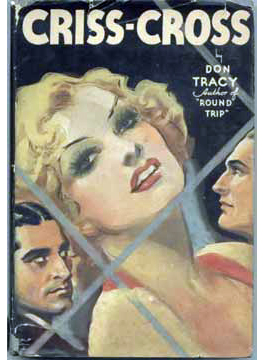 A less famous example comes from 1934, Don Tracy’s novel Criss-Cross. Here an alienated loner finds that his long-ago girlfriend has married a local crook. To get her back, the hero agrees to be the inside man in a robbery of the armored truck he drives. The heist goes badly, with the hero shooting the gangster and getting shot himself. He’s acclaimed as a hero, but fate catches up with him when a blackmailer who knows the truth starts putting the squeeze on him. Where The Asphalt Jungle ranges across many characters’ knowledge in a fairly tight time span, Criss Cross restricts its point of view to the protagonist but traces his life over a long period. These storytelling options, ingredient to any narrative whatsoever, will shape how the heist plot is handled.
A less famous example comes from 1934, Don Tracy’s novel Criss-Cross. Here an alienated loner finds that his long-ago girlfriend has married a local crook. To get her back, the hero agrees to be the inside man in a robbery of the armored truck he drives. The heist goes badly, with the hero shooting the gangster and getting shot himself. He’s acclaimed as a hero, but fate catches up with him when a blackmailer who knows the truth starts putting the squeeze on him. Where The Asphalt Jungle ranges across many characters’ knowledge in a fairly tight time span, Criss Cross restricts its point of view to the protagonist but traces his life over a long period. These storytelling options, ingredient to any narrative whatsoever, will shape how the heist plot is handled.
Criss-Cross and The Asphalt Jungle show that we’re dealing with an exceptionally schematic plot pattern. For convenience we can distinguish five parts.
Circumstances lead one or more characters to decide to execute a heist (robbery, hijacking, kidnapping).
The initiators recruit participants.
As a group they are briefed and prepare their plan. They study their target, rehearse their scheme, or take steps to make it easier.
The heist itself begins and concludes.
The aftermath of the heist, failed or successful, shows the fates of the participants.
There are other conventions, nicely laid out by Stuart Kaminsky in 1974 and more recently by Daryl Lee. But I’ll just concentrate on this structure and how it governs narration, because these aspects show very clearly the constant dynamic of schema and revision in the filmmaking tradition.
Four capers, mostly unhappy
Criss Cross (1948).
Four films in the period covered in my book point toward the heist genre, though only one became a core instance. The presence of a “consolidating” film might be one way genres emerge.
The earliest candidate is an unlikely one. In 1941 Laura and S. J. Perelman mounted a notably unsuccessful play called The Night Before Christmas, a farce in which crooks buy a luggage store in order to tunnel from its basement into the bank vault next door. Although Paramount was a backer of the stage show, Warners bought the rights and revamped it for Edward G. Robinson, who had had success in gangster comedies like A Slight Case of Murder (1938). The adaptation, Larceny, Inc. (1942) maintained the premise but revised the plot, multiplying the complications that face the leader Pressure and his two minions. The twist is that thanks to Pressure’s daughter, who’s unaware of the scheme, business starts booming and the crooks find themselves prosperous businessmen. Woody Allen swiped the premise for his Small-Time Crooks (2000).
Just as we don’t expect a comedy to be the initial entry in a genre mostly associated with drama, we might expect that the early entries in the genre would be the tidiest, with complex variations building on them. Actually, two precursors of The Asphalt Jungle display remarkable complexity.
The simpler one, Criss Cross (1948), starts late in the preparation phase: the night before the caper, when the gang is holding a party to distract a local cop who has his eye on them. We learn that Steve is working with Slim’s wife Anna to double-cross the gang. The next day, Steve is driving the armored car and recalling how he got into this situation. A flashback provides the circumstances for the robbery—Steve’s pursuit of Anna, her marrying Slim, and Steve’s impulsive proposal of a robbery to protect Anna from Slim’s punishment.
Next comes the planning phase. The robbers assemble and the task is reviewed by a mastermind they hire. This second flashback ends and, back in the present, we see the heist itself. The aftermath of the bloody robbery shows Steve in the hospital, honored by the community. A thug kidnaps him and takes him to Anna. Slim has survived the gun battle and finds the couple; he kills them before he is mowed down by the police.
Early as Criss Cross is in the history of the film genre, the plot components are already being scrambled. Thanks to 1940s Hollywood’s commitment to flashbacks and character subjectivity, the novel’s linear action gets fractured, compressed, and stretched. Moreover, in most films, the decision to pull the heist is made fairly early. Here and in the novel, circumstances slowly force Steve to rescue Anna from the man who mistreats her. The buildup to this decision consumes nearly fifty minutes of an 87-minute movie. Similarly, the aftermath of the heist is quite protracted, running about twenty minutes. And whereas other films (and novels) dwell on the recruitment of thieving talent, here this is elided. That’s because the other members of the gang are less significant than the central triangle of Steve, Anna, and Slim.
The Killers (1946) is even more complex because it clamps the block construction of Citizen Kane onto the heist schema. We start with one bit of the heist aftermath: the death of the gas-station attendant Ole. Like Kane, who also dies in his bed at the start of his film, Ole is the protagonist of the past-tense story. We next meet the protagonist of the present-time story, the insurance investigator Riordan, who functions like the reporter Thompson in Kane, and sometimes even gets the same silhouette treatment.
The rest of the film splits up the basic parts of the heist schema, rearranges their order, and presents them through a series of several flashback blocks, anchored in six characters’ testimony.
The heist itself is very brief, running only about two minutes, and the planning phase is only a little longer. As in Criss Cross, the leadup and the aftermath constitute the bulk of the film, but these phases are broken up into many bits, and these are often shuffled out of chronological order. We see Ole’s discovery by Big Jim years after the heist and then we see Ole, days after the heist, distressed that his lover Kitty has betrayed him. Similarly, a crucial event after the heist—Ole’s stealing the loot from the gang—precedes a scene before the heist in which he learns the gang is planning to double-cross him. We have to reconstruct the canonical sequence, from circumstance to aftermath, out of fragments revealed in testimony taken by Riordan.
Critics haven’t taken Criss Cross and The Killers as the first core instances of the heist film, perhaps because these movies complicate the classic plot template. In addition, they downplay the planning and execution phases. The heist scenes are relatively minor compared to the time devoted to other phases, particularly the circumstantial buildup. Moreover, the robber teams aren’t vividly characterized and don’t display a range of expertise. The emphasis falls on Steve and Ole, both played by Burt Lancaster, as the beautiful losers who become suckers for treacherous women and their brutal men.
By contrast, the linearity of The Asphalt Jungle throws the plot template into crisp relief. Both novel and film offer a full-blown enactment of central features picked out by Stuart Kaminsky. The gang, despite low social standing, has many skills. They’re held together by a leader who may also be a brainy planner. The robbers’ plan requires “skill, practice, training, and above all, perfect timing.” The gang’s resourcefulness is tested by accidents. The caper is partly successful but largely a failure, often through sexual weakness on the part of some players.
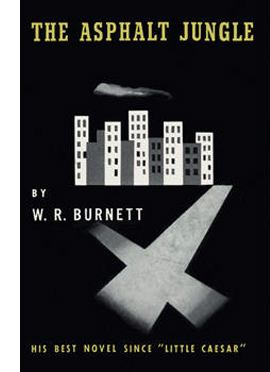 W.R. Burnett’s book opens up the wide narrative possibilities of the genre, thanks to an expanded group of characters. Where Don Tracy’s novel Criss Cross confined itself to relatively few figures, Burnett innovates by developing no fewer than eighteen distinct individuals, all somehow connected to the jewel robbery. New roles are assigned that will be staples of the genre—financier, go-between, bent cop, owner of a safe house. We see policemen of all ranks, a news reporter, the master mind Dr. Riedenschneider, the fixer Cobby, the bankroller Emmerich (who has a wife, a mistress, and a hired detective), and the four men on the team, two of whom have women attached.
W.R. Burnett’s book opens up the wide narrative possibilities of the genre, thanks to an expanded group of characters. Where Don Tracy’s novel Criss Cross confined itself to relatively few figures, Burnett innovates by developing no fewer than eighteen distinct individuals, all somehow connected to the jewel robbery. New roles are assigned that will be staples of the genre—financier, go-between, bent cop, owner of a safe house. We see policemen of all ranks, a news reporter, the master mind Dr. Riedenschneider, the fixer Cobby, the bankroller Emmerich (who has a wife, a mistress, and a hired detective), and the four men on the team, two of whom have women attached.
The novel lays out the canonical action phases with surgical efficiency. But as in the films I’ve just mentioned, the planning and the heist itself take relatively little space. Given so many characters’ contribution to the action, their gradual convergence and their dispersed fates dominate the book. Over a hundred pages are devoted to setting up the circumstances and recruiting the gang. The aftermath, tracing the outcome for all involved, runs another 140 pages.
The film adaptation retains the novel’s scope, trimming only a couple of minor characters. It moves briskly among the ensemble, attaching us to several in turn, so we know more than any one character does. The narration creates parallels among the team members and their affiliates (such as four women of different classes, with varying commitments to their men).
The result is something of a network narrative, a cross-section of several people whose lives change because of the robbery. There’s no clear-cut protagonist like Steve in Criss Cross. Dr. Riedenschneider has the most screen time, but the film begins and ends with the hooligan Dix, and the fate of both men dominates the climax. I point out in Reinventing Hollywood that a multiple-protagonist film often gives extra weight to one or two characters.
50s and 60s stylings
Violent Saturday (1955).
With The Asphalt Jungle as a robust prototype, writers and filmmakers developed the heist plot throughout the 1950s and 1960s. Despite his clumsy style (”He nodded with his head”), Lionel White became known as “the king of the caper novel” for his tireless variants on robberies, hijackings, and kidnappings. The other major figure was the far superior Donald Westlake, who wrote brutal heist tales as “Richard Stark” and comic ones under his own name.
In the comic register, Westlake was beaten to the post by heist films from England. The Lavender Hill Mob (1951) showed a timid clerk engineering the theft of gold bullion, which he disguises as kitschy miniature Eiffel Towers. The Lady Killers (1955) centered on a gang fooling their landlady into thinking that their planning meetings are actually string-quartet sessions. In Italy, the classic Big Deal on Madonna Street (I soliti ignoti, 1958) showed five incompetents trying to break into a pawnshop safe.
Big Deal was considered a parody of a much more serious film, one that was by then a landmark: Rififi (Du rififi chez les hommes, 1955). It did a great deal to consolidate the genre in France, along with Touchez pas au grisbi (1954) and Bob le flambeur (1956). (Both The Killers and Criss Cross had been imported in the Forties.) In England, the heist drama was seen in The Good Die Young (1954), while in the US there were 5 Against the House (1955), Violent Saturday (1955), Plunder Road (1957), The Big Caper (1957, from a White novel), and Odds Against Tomorrow (1959). The year 1960 saw a remarkable number of releases, with The League of Gentlemen (U.K.), The Day They Robbed the Bank of England, Seven Thieves, and most famously Ocean’s 11 (all U.S.).
Through the 1960s the genre proliferated, including a remake of The Asphalt Jungle (Cairo, 1963), Jules Dassin’s near-self-parody of Rififi (Topkapi, 1964), and a string of heist films that mixed in romantic comedy (e.g., Gambit, 1966; How to Steal a Million, 1966). The Italian Job (1964) became a cult movie, with tourists visiting the sites of shooting in Turin. The genre has remained robust throughout world cinema ever since.
The very rigidity of its format and the constraints it lays down, have allowed for ingenious innovations. I’ll sample some of those from the genre’s first dozen or so years, concentrating on three areas: the differing emphasis given to the plot phases; variants of point-of-view; and manipulations of time.
Where’s the action?
Rififi (1955).
The Asphalt Jungle offers a fairly pure geometry: the heist, lasting about eleven minutes, ends just before the film’s midpoint. On the other side of that is another big scene: a gunfight initiated by Emmerich’s henchman Brannom when Dr. Riedenschneider and Dix bring in the loot. That confrontation takes another seven minutes, so the heist and its immediate wrapup sit at the center of the running time. What led up to the heist, the circumstances, recruitment, and planning phases, consume the first forty-five minutes of the film, and the aftermath of the heist, affecting the surviving characters, will take just about as long. This balanced geometry, putting the heist snugly at the center of the plot but devoting most time to showing many lives leading up to and away from the crime, suits the extensive characterization of all involved.
This is a neat structure, but not the only possibility. Any phase of the action can be given great weight. The first half hour of Bob le flambeur is an episodic introduction to Bob’s routines and associates. It’s the circumstantial phase—he’s running out of money—presented at low pressure, emphasizing instead the fascinating milieu Bob coolly drifts through. Only when Roger points out a croupier at the Nantes casino does Bob formulate “the job of a lifetime.” Then crew assembly and planning can begin. As the plot develops, characters and relationships presented casually in the exposition become crucial to the heist and its unraveling.
Other phases can be stretched out. Ocean’s 11 dwells on the phase of gathering the talent. Before the start, Danny Ocean has already conceived the heist, but we aren’t told the plan. Instead we watch his team members converge on Las Vegas. Not until the film’s midpoint, at 53:00, is the plan revealed in a briefing. The dawdling exposition suits a film about cool guys hanging out.
The formation of the crew is exceptionally protracted in Odds Against Tomorrow, because here two members hesitate about participating. The racist Earl Slater, wracked by the shame of not providing for his wife, finally gets her to agree to let him join. Not until twenty-three minutes from the end does the African-American musician Johnny Ingram finally accept a role in the heist, which immediately becomes the film’s climax.
The source for Odds Against Tomorrow (one of the better heist novels) handles the basic pattern very differently, putting the heist just before the midpoint and devoting the second half of the book to the increasingly hopeless getaway, where the interracial tensions play out at length.
The planning phase sometimes includes a rehearsal for the heist, and that may require a subsidiary crime, such as stealing keys or a vehicle. The League of Gentlemen has an unusually long planning phase, in which the gang masquerades as soldiers in order to seize weapons from a military post. This robbery, running nearly twenty minutes, takes longer than the film’s main heist but serves to demonstrate the team’s resourcefulness and esprit de corps. The men’s precision and resourcefulness (based on their wartime experience) lead us to expect a successful main event.
Kaminsky suggests that the big-caper genre resembles the soldiers-on-a-mission movie, which centers on the details of a process executed by skillful specialists. That display of process comes to the fore in The Asphalt Jungle’s central robbery, which initiated the convention of detailing the mechanics of the heist. Other films expanded the heist sequence to larger proportions than was evident in The Killers or Criss Cross. Rififi became the model; its heist runs twenty-five minutes without any words being spoken. (That sequence is part of an even longer wordless stretch that runs over thirty minutes.) Dassin’s film meticulously breaks down the steps of a complicated robbery, allowing us to appreciate the men’s clever planning while, as usual, ratcheting up moments of suspense when it appears they might fail.
After Rififi, heist scenes got longer and more intricate. The one in Big Deal on Madonna Street runs twenty minutes, those in Seven Thieves and The Day They Robbed the Bank of England run thirty minutes, and those in Topkapi and The Italian Job approach forty minutes. To motivate these long, virtuosic passages, there need to be many obstacles, many ingenious ways around them, and many characters concentrating on their assigned duties.
Long or short, the heist can be shifted off-center. The heist can be the climax, as in The Big Caper, or it can be virtually the film’s entire second half, as in The Italian Job (which arguably doesn’t complete the heist and so never provides a proper aftermath). Topkapi’s flamboyant robbery, involving elaborate subterfuges, dominates the film’s latter stretches, leading to a quick reversal in its epilogue. The heist is finished early on in The Lady Killers, since the crucial action is the long aftermath in which, contradicting the title, the crooks dispose of one another. By contrast, the heist dominates nearly all of Larceny, Inc. Most of the film is devoted to the crooks’ slowly deepening tunnel, as the process is interrupted by breaks in the water main, a geyser of furnace oil, and their decision to abandon their plan in favor of going straight—before another crook comes along to continue the caper.
Or the heist can launch the film. In Plunder Road, after the train robbery is completed, the rest of the film is the aftermath, consisting of chases and suspense sequences. The circumstances, recruitment, and planning phases are alluded to in dialogue, as suits a low-budget production. The plot of Touchez pas au grisbi starts the morning after the caper and shows thieves trying to protect their loot from a treacherous drug dealer. It was probably inevitable that somebody would make a heist movie that keeps the heist offscreen and makes the action one long aftermath.
Steering the moving spotlight
Topkapi (1964).
Many films based on mystery rely on restricting a character’s range of knowledge, as in detective novels told in the first person. But suspense, Hitchcock and others recognized, relies on greater access to story information. If there’s a bomb under the table, Hitch advised, tell the viewer but don’t tell the characters. The heist film, as an account of how a crime is committed, depends more on suspense than mystery. So we’d expect a constant shuttling from character to character, filling us in on how the scheme is going and letting us worry about impending dangers.
This is generally what we find. Criss Cross is unusual in confining us to what Steve knows about Anna’s and Slim’s real agendas, and this confinement is what yields the surprises that pop up in the film’s final stretches. Mostly, though, heist movies and novels use omniscient narration. Employing what I call in Reinventing Hollywood the “moving spotlight” approach, the film shifts us from attachment to one character to another.
The moving spotlight permits us to understand the choreography of the crime, in which many characters play a part, and to feel suspense when matters of timing or accident intrude. Indeed, the convention of the unforeseen accident that spoils the heist relies on our breaking attachment to the crooks and getting privileged access to the off-schedule night watchman, the passing witness, or the failed piece of machinery. In Topkapi we and not the thieves learn how a stray bird will upset their getaway.
This omniscient narration (which need not tell us absolutely everything) can be deployed in a range of ways. One option is chapter titles, as in Big Deal on Madonna Street (and revived by Tarantino in Reservoir Dogs). A more common resource is the non-character narrator, present as an authoritative voice-over. In Bob le flambeur, a worldly male voice introduces us to Bob’s daily routine and comments somewhat cynically on his place in his milieu.
A similar all-knowing voice introduces us one by one to the heisters in The Good Die Young; there it eases the transition into expository flashbacks. Topkapi treats this convention, as others, with self-conscious playfulness. At the beginning the beguiling woman in the gang addresses the camera and explains that the heist aims to get the emerald she covets. She doesn’t take this narrating role again until the very end, in a brief epilogue that replays the gathering of the gang in stylized form.
Heist films must often choose whether to widen the field of view to include either the cops or civilians. Armored Car Robbery (1950), for me a peripheral instance of a heist film, alternates the gang’s activities—which do pass through the phases I’ve outlined—with the detectives’ investigation. The result is balanced between heist film and police procedural. Something similar happens in Violent Saturday (1955), which devotes most of its plot to a gang’s scheme to rob a mining town’s bank. Crosscut with the gang’s gathering and planning are scenes showing several members of the community, each with domestic problems. These scenes, typical of small-town melodrama (dissolute rich people, sexy nurse, repressed librarian, lovelorn bank manager), not only pad out the film but show us characters who will be affected by the heist. Some become witnesses and bystanders during the robbery, one is killed, and one, a local mining manager, will be forced to fight the gang at the climax.
The timing and selection of the shifts among characters can build up specific effects. For instance, in Big Deal on Madonna Street, the heist is conceived by Cosimo, a hardheaded crook doing time. A handful of would-be crooks decides to execute the robbery without him. We know, as the gang does not, that he has been released and is conspiring to interfere. The filmmakers could have made Cosimo’s return a surprise revelation, but instead our expectation that he’ll start meddling intensifies our interest.
Similarly, we know, as the Topkapi gang does not, that Arthur is a police spy. But then he confesses to them, so we know, as the Turkish police do not, that he is to be a double agent. The film milks suspense during the scenes in which Arthur relays information to the authorities, and then it makes us wonder how the gang will use their new knowledge of police surveillance. This is the sort of fine-tuned choice about “who knows what when” that heist films must make at every turn.
At a more granular level, when the spotlight is on one character, the filmmakers must choose whether to make those moments, shot by shot, highly restricted or not. In The Killers, Nick Adams’ account of Ole’s reaction to the stranger stopping for gas is more or less plausibly limited to Nick’s ken. But the precise exchange of glances between the driver and the Swede signal to us that Ole has been recognized. Nick doesn’t register this, since he’s standing at the rear of the car (barely visible in my first still, over Ole’s right shoulder).
In effect, this is a narrational aside to the audience. Nick can’t see this significant exchange of glances, and his voice-over doesn’t specify it, so we can’t assume Riordan learns of it. But this privileged moment primes us to see Big Jim as a major menace in scenes to come. This sort of deviation from what a character could plausibly know or notice is common in cinematic narration and differentiates it from literary narration, which is more tightly restricted in handling “point of view.” Classical Hollywood is biased toward unrestricted narration; radical restriction is rare. The heist genre can exploit many fine gradations between attachment to a character and more wide-ranging knowledge.
What’s our clock?
The Killing (1956).
As we’ve seen, two early instances of heist films break with a linear layout of the story. Criss Cross presents what Reinventing Hollywood calls a crisis structure, beginning just before the turning point and flashing back to show what led up to it. The Killers has a refracted narration, with all of the past events passed to the investigator Riordan and us through witnesses’ testimony. The flashbacks in Criss Cross are chronological, but those in The Killers are drastically out of order.
Time-scrambling, then, seems to be especially welcome in the heist film (as not, say, in the Western). The basic plot pattern is such a simple one that shuffling phases or parts of phases doesn’t create confusion. Yet few films of the 1950s I’ve found display the complexity of the Forties examples. Indeed, a time-juggling heist novel, The Lions at the Kill (Simon Kent, 1959) was ironed into straightforward linearity in the film version, Seven Thieves.
The Good Die Young displays a more complicated structure. It begins at a point of crisis, with four men driving in a car to the site of the caper.
The voice-over narrator introduces each man in turn, and then a long flashback explains his backstory. Deprived of information about the heist, we have to wonder how the narration will bring the men together and create their plan.
After the long section explaining each man’s circumstances, all involving women and money, the flashbacks meld. The men gradually come to know each other through frequenting the same pub. Their desperation pushes them toward accepting one man’s proposal that they rob a post office. With so much time spent on preparation and assembly, the actual planning is necessarily brief. Eventually the final flashback flows seamlessly into the present-time situation, initiating a brief replay of the dialogue in the car that opened the film. The heist (devolving into a disastrous gun battle) initiates the climax, and an airport aftermath concludes the film.
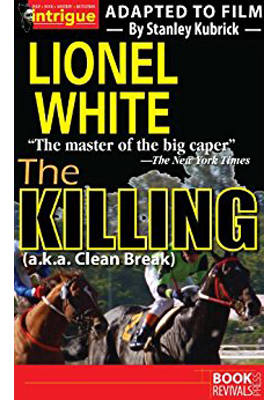 The most ambitious 1950s recasting of the nonlinear efforts of the 1940s films is The Killing (1956). The source novel, Lionel White’s Clean Break (1955) consists of interwoven threads. A crook, his pal, a cashier, a bartender, and a crooked cop conspire to rob a racetrack. They will employ helpers to start a fistfight and shoot a racehorse. The early chapters devote short stretches to following each one, already recruited, through the circumstances phase of the heist template. The men assemble at their planning meeting, which is invaded by the snoopy wife of the weak cashier. She then tells her boyfriend about the heist, so another strand involving other characters is introduced.
The most ambitious 1950s recasting of the nonlinear efforts of the 1940s films is The Killing (1956). The source novel, Lionel White’s Clean Break (1955) consists of interwoven threads. A crook, his pal, a cashier, a bartender, and a crooked cop conspire to rob a racetrack. They will employ helpers to start a fistfight and shoot a racehorse. The early chapters devote short stretches to following each one, already recruited, through the circumstances phase of the heist template. The men assemble at their planning meeting, which is invaded by the snoopy wife of the weak cashier. She then tells her boyfriend about the heist, so another strand involving other characters is introduced.
On the day of the robbery, White’s narration again attaches itself seriatim to each man as he executes his role in the scheme. While the early part of the book had a few mild jumps back in time to follow each heister, the day of the job creates extreme back-and-forth shifts. We follow the bartender, for instance, going to the track on the fateful day, before the next subchapter skips back to the cashier waking up and then going to the same train. In a later section, we skip back to the previous day and attach ourselves to the sniper who will shoot the racehorse. Because of the overlapping lines of action, the shooting of the horse and the starting of the bar fight are presented twice. Everything eventually converges on Johnny Clay, the mastermind, who breaks into the money room and steals the day’s revenue.
These temporal overlaps emerge partly from the description of the action, but they’re also marked by either characters looking at clocks or watches, or by explicit mention in the prose, such as “It was exactly six forty-five when…”
The film version makes these overlapping schedules much more explicit. A detached voice-over describing police routine or criminal behavior had become a commonplace in the 1940s, in both “semidocumentary” films and in radio drama, notably Dragnet. In The Killing, apart from lending an aura of authenticity, the voice-over exaggerates the time markers of the novel by introducing scenes crisply. The first five scenes are introduced with these tags:
“At exactly 3:45…”
“About an hour earlier…”
“At seven PM that same day…”
“A half an hour earlier…”
“At 7:15 that same night…”
These lead-ins remind us of the ticking clock, set up parallels among the characters, and get us acclimated to the film’s method of tracking one character, then jumping back in time to track another. This is moving-spotlight narration on markedly parallel tracks. The same method will be applied during the heist, when ten consecutive scenes and several others will be tagged in the same way. (“Mike O’Reilly was ready at 11:15.”)
It’s not just the repetitions that exaggerate White’s jagged time scheme. When the sniper Nikki is shot after plugging the racehorse, the narrator reports drily: “Nikki was dead at 4:24.” Cut to Johnny leaving a luggage store, and the voice-over announces: “At 2:15 that afternoon Johnny Clay was still in the city.”
The time jumps more or less buried in White’s prose are made dissonant in the film. Here the juxtaposition heightens the likelihood that Johnny’s robbery won’t go according to plan.
The replays are no less sharply profiled. As the scenic blocks move from character to character and skip back in time, they include actions we’ve already seen. The most persistent is the repetition of the track announcer’s calling the start of the crucial seventh race, but we also get replays of the wrestler Maurice starting a fight, the downing of the horse, and glimpses of Johnny waiting to slip into the cash room.
Instead of shuffling flashbacks in the manner of The Killers, The Killing offers brief time chunks stacked in slightly overlapping array until they all square up in a single moment, the consummation of the robbery. This structure allows for the sort of character delineation we find in The Asphalt Jungle while also offering the audience a formal game to enjoy. Kubrick’s film can be seen as pointing in two directions—revising the flashback format of the 1940s entries, but becoming a point of reference for later filmmakers eager to innovate games with time and viewpoint that would remain comprehensible to the audience.
The Killing helped make Clean Break White’s most famous novel. It was often republished under the film’s title. Perhaps in a grateful spirit White’s 1960 novel Steal Big (1960) included this scene.
Donovan didn’t look at the half-dozen worn, barely legible signs in the dingy lobby of the building. He went at once to the elevator and asked for the fifth floor. Getting out of the elevator, he turned left, took a dozen steps and knocked on a pebbled-glass door. The door bore the legend, KUBRIC NOVELTY COMPANY.
Mr. Kubric, it turns out, supplies illegal guns and explosives.
Art for artifice’s sake
Inside Man (2006).
White’s in-joke, along with The Killing’s gamelike approach to structure, reminds us that whatever its claim to realism, this is a highly artificial genre. The strict template and the ritualistic steps in it—recruiting the crew, casing the target, checking watches—invite filmmakers to tinker with self-conscious narration that lets the viewer in on the joke.
One convention, that of the rehearsal for the big job, is flaunted in Bob le flambeur, when the narrator simply breaks into the film with the line, “Here’s how Bob pictured the heist,” and we get a stylized, hypothetical enactment of the job carried off perfectly. In these films, when the rehearsal goes well, you know the real thing will face problems.
Something similar, though suited to light comedy, takes place in Gambit. Here we think we’re seeing the heist as executed (across twenty-three minutes), but it proves to be no more than the fantasy of the crook hatching it. Again, everything that succeeds in the fantasy goes wrong in reality.
As it gained a profile, the genre got reflexive. In the novel that was the source for The League of Gentlemen, the heisters explicitly model their plan on the one in Clean Break. The film version likewise sets its heisters mimicking a pulp novel, though it didn’t specify the title. And in The Wrong Arm of the Law (1963), Peter Sellers’ cockney mastermind promises to show his henchmen “educational films and training films” like Rififi, The Day They Robbed the Bank of England, and The League of Gentlemen.
The opportunities the genre provides for experimenting with story stratagems, sometimes in very self-conscious ways, seem to have been part of the reason later filmmakers tried their hand at it. In the 1990s and 2000s, writers and directors drawn to neo-noir and narrative experiment took up thriller conventions generally, and the heist film was one option.
In Reservoir Dogs (1992), Tarantino revived the shuffling of time and viewpoint that was ingredient to the genre. Although the film pays homage to Clean Break, its form is no less indebted to Criss Cross. Like that film, it flashes back from the day of the heist in order to run through the canonical phases of action. And as in The Killers, those phases are scrambled out of order. Brian Singer’s The Usual Suspects (1995) brings the (very ‘40s) device of the lying flashback to the genre, within the template of police questioning after the heist. Inside Man (2006) mixed to-camera narration, flashbacks, and flashforwards to interrogations after the crime.
Among Americans it’s Steven Soderbergh who has returned to the caper film most frequently. The Underneath (1995) is a remake of Criss Cross, with an extra layer of flashbacks. Logan Lucky (2017), with its deadpan redneck losers, joins the tradition of comic heist movies. Most strikingly, the Ocean’s series makes a virtual fetish of the male camaraderie and playful plot tricks typical of the genre. The films pepper the action with voice-overs, cunning ellipses, and flashbacks within flashbacks. The plots hide key information about the plan. They fill the action with in-jokes, such as a star cameo by Bruce Willis commenting on box-office grosses. Like 1960s films, they incorporate romantic comedy. In Ocean’s Eleven ((2001) Danny and Tess arrange a post-divorce reconciliation, and in Ocean’s Twelve (2004) Danny’s pal Rusty gets involved with police agent Isabel.
Piling up obstacles, reversals, bluffs, and double-bluffs, the films form a kind of anthology of the genre’s tricks. By the time we get to Ocean’s Thirteen (2007), the early phases of the standard plot schema can be given short shrift. We know the gang and its modus operandi, so the bulk of the film becomes a mind-bogglingly intricate heist including everything from planting bedbugs in a hotel room to manufacturing loaded dice in a Mexican factory under threat of strike. The network of rules and roles laid out in the 1950s—master mind, aged expert, financier, crooked helpers, allies and rivals and go-betweens and stooges—are given baroque elaboration and treated with an almost self-congratulatory panache.
So am I looking forward to Ocean’s Eight? It’s directed by Gary Ross, so I don’t expect Soderbergh’s casual sheen. And the target of the heist, a fashion show at the Met, may be a bit too on the nose; why can’t the ladies tackle a payroll or a munitions factory? Still, like a butterfly collector looking for new specimens, I’m quite curious. When it comes to narrative strategies, I’m a sucker for a fresh con.
Thanks to Jim Healy and Geoff Gardner for discussion of the genre.
Stuart Kaminsky’s American Film Genres: Approaches to a Critical Theory of Popular Film (Plaum, 1974) is a trailblazing study, and the chapter on the “big-caper” film is an indispensible starting point for studying this kind of movie. Later editions of the book eliminated this chapter. A wide-ranging recent survey is Daryl Lee’s The Heist Film: Stealing with Style (Wallflower, 2014). Alastair Phillips offers an in-depth analysis of a classic in Rififi (Tauris, 2009).
My quotations from Donald Westlake come from Murderous Schemes: An Anthology of Classic Detective Stories (Oxford University Press, 1996), pp. 1 and 126. I also found the entry on Lionel White in Brian Ritt’s Paperback Confidential: Crime Writers of the Paperback Era (Stark House, 2013) helpful. The “KUBRIC” passage in White’s Steal Big (Fawcett, 1960) is on p. 47. White much influenced Westlake, as I hope to show in a future entry, but Westlake was a far superior stylist, as I discuss a little in this entry. See also this note on Levi Stahl’s anthology of Westlake nonfiction.
For more on analyzing narrative see “Three Dimensions of Film Narrative” and “Understanding Film Narrative: The Trailer.” Tarantino’s debts to the 1940s are reviewed in this entry. See as well my recent entry on thrillers. I analyze the convoluted narrative of The Killers in Chapter 9 of Narration in the Fiction Film. The Way Hollywood Tells It: Story and Style in Modern Movies discusses 1990s filmmakers’ relation to the Forties. Multiple-protagonist plotting is considered in Chapter 3 of Reinventing Hollywood: How 1940s Filmmakers Changed Movie Storytelling.
The concept of schema and revision is considered here as applied to style; this entry, like Reinventing, applies it to narrative principles. My Dunkirk entry points out affinities between the overlapped time frames in The Killing and the three-track scheme Nolan gives us. Unlike Kubrick, Dunkirk applies the principle to the entire film and assigns each timeline a different duration, but it generates a back-and-fill organization and clusters of replays reminiscent of The Killing.
Burt Lancaster is considered here, and why not?
P. S. 26 March 2020: Thanks to Adrian Martin for correcting two slips in my account of Criss Cross!
Ocean’s Eight (2018).
Ritrovato 2017: Many faces, many places
Agnès Varda and JR, Il Cinema Ritrovato, 1 July. Photo: DB.
DB here:
This final post from Il Cinema Ritrovato is no less a miscellany than the others. With over 500 films screened, Kristin and I invariably missed things that others raved about. Still, we saw enough powerful cinema to make us want to flag some key items for you.
Silents, please
Kristin has already mentioned one of the most startling items we saw, Le Coupable (1917) by André Antoine. I’m still processing the audacity of this film. The prosecutor in a murder trial abruptly claims the defendant as his son. We then get the familiar flashback format, shifting from the courtroom to the events leading up to the crime and the arrest. But the shifts between present and past are so quick, and the bits we see of the trial are given in such intense, stark singles, that they gain an astonishingly modern pulse.
Add in marvelous use of locations, real alleys and corridors and cafes, and you have a very impressive movie.
Once more, 1917 proves to be dynamite.
From the same year came Furcht (Fear), by Robert Wiene. Count Grevin wanders anxiously through his castle for about sixteen minutes of screen time before we realize, thanks to a flashback, that he’s haunted by his theft of a precious Indian statue, stolen from a temple. Soon a priest materializes, either on the castle grounds or in Grevin’s imagination, to declare that he has only seven years to enjoy life before vengeance strikes. Which it does, of course. Conrad Veidt plays the priest with the smoldering glare, and ambitious superimpositions show how committed German cinema was to special effects. Dr. Caligari was three years off.
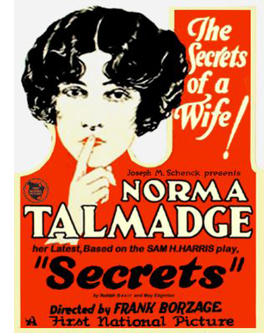 Not that other years should be slighted. Le Collier de la danseuse (The Dancer’s Necklace, 1912) was an agreeably preposterous crime movie. (The thief has a jacket with fake hands dangling from the sleeves, just the thing for escaping handcuffs.) The film boasted the low, almost Ozuesque, camera height typical of other Pathé productions of the year.
Not that other years should be slighted. Le Collier de la danseuse (The Dancer’s Necklace, 1912) was an agreeably preposterous crime movie. (The thief has a jacket with fake hands dangling from the sleeves, just the thing for escaping handcuffs.) The film boasted the low, almost Ozuesque, camera height typical of other Pathé productions of the year.
Borzage’s Secrets (1924) traces a marriage through three large flashbacks, with the first emphasizing romantic comedy, the second suspense, and the third family melodrama. Norma Talmadge, who savored a split-personality role in De Luxe Annie (1918), gets to play a woman at three ages here. The central section, devoted to a Griffithian siege on a lonely frontier cabin, showed Borzage’s ability to whip up enormous excitement, with an unexpectedly sad twist. The whole movie has over 11oo shots, indicating just how committed American filmmakers had become to fine-grained scene breakdowns.
All in all, the silent films on display this year were as revelatory as ever.
Cinematic geometries
The Abe Clan (1938).
For some years Ritrovato has included a Japanese sidebar curated by Alexander Jacoby and Johan Nordström. This year the theme was socially critical jidai-geki, or historical films. Some of them were fairly familiar to Western cinephiles because copies were circulated by the Japan Film Library Council from the 1970s onward. Examples include The Abe Clan (1938) and Fallen Blossoms (1938), both very good films. Along with these, the Bologna series gave the Yamanaka Sadao classic Humanity and Paper Balloons (1937) another well-deserved airing.
Some of these are fairly intimate dramas, others use a lot of spectacle. The image from Abe Clan above is fairly typical of the monumental turn some jidai-geki took in the late 1930s. Several of the films starred members of the left-wing Zenshinza kabuki troupe, perhaps best known to aficionados from Mizoguchi’s staggering Genroku Chushingura (1941-1942).
Three of the other films showed the range of this genre during Japan’s “dark valley,” its turn to authoritarian rule and imperial warfare. The Rise of Bandits (1937), by Takizawa Eisuke, was a rousing but melancholy Robin Hood tale. A lord’s honest son tries to save a shipment of gold from marauders, but he’s framed by his duplicitous brother. So he becomes the outlaws’ leader, at the cost of his wife’s life and his father’s trust. Some superb action sequences, including a fiery final assault on the castle, alternate with semicomic scenes among the bandits, with the hero’s cynical sidekick twisting not-too-bright thugs around his finger.
Hagiwara Ryo’s The Night Before (1939, production still above) was based on a Yamanaka script, and like Humanity and Paper Balloons, it braids together several characters’ fates. As rival samurai factions struggle during the Meiji restoration, ordinary people–an artist, a family running an inn, a young man wanting to make his name as a warrior, a bitter and disenchanted samurai–try to get by. One of the innkeeper’s daughters is attracted to the youth, another daughter who works as a geisha eyes the artist, and the old man seems to escape into endless games of shogi with a neighbor. The film has a panic-stricken climax, in which the factions collide in darkness along the riverside and innocents get swept up in the violence. As with many films in the series, the critique of mindless militarism isn’t far below the surface.
The Man Who Disappeared Yesterday (1941), by the great Masahiro Makino, is a murder mystery. An unpleasant landlord is the victim, and there are plenty of suspects. The scattered clues didn’t seem to me to play entirely fair, but the investigation is largely a pretext to explore adjacent households and obfuscate what turns out to be complicated post-murder maneuvers. At the climax, all the suspects are seated in a single line to hear the magistrate’s solution, just as if they were in Nero Wolfe’s office.
Makino’s style accentuates the spatial layout through a remarkable ten zoom-ins that yank us to one or another suspect as the explanation is given, sometimes with flashbacks. Camera zooms (as opposed to optical-printer ones, as in Citizen Kane) are rare in any national cinema of this period, and Makino uses them almost in the spirit of Hong Sangsoo, more to perk up our attention than to enlarge anything for closer scrutiny. (Admittedly, the last one rivets us on the guilty party.) The same geometrical impulse encloses the tale: an opening crane shot down, a closing one upward. As often in Japanese cinema, The Man Who Disappeared Yesterday marks and repeats film techniques to give a decorative flourish to the story.
Technique also comes to the fore, of course, in Divine (1935), a French production directed by Max Ophüls. The attraction isn’t just the dizzying camera movements, swimming through a tangle of backstage paraphernalia and crawling up stairways. Max is more than a master of the tracking shot. In one witty passage, framing and cutting coordinate to stretch the distance between a couple who can’t tear themselves away from each other. (In my last frame, the milkman’s head slides almost out of frame.)
The plot centers on a country girl who becomes a follies performer and is framed as a drug dealer by a Lothario and a lesbian. This contraption seems more or less a pretext for Ophüls to indulge his endless fascination with women striking poses for men while asserting their own demands. The abrupt and unexplained happy ending is the logical wrapup for a film less concerned with a plausible plot than a display of Woman in all her dazzling divinity. There. How’s that for a Sarris sentence?
Bigger than life
Although there were some repeats on Sunday, the final big event of the festival was the screening, to some 3000 people on the Piazza Maggiore, of the new film by Agnès Varda and JR. Kelley Conway reviewed its Cannes premiere for us earlier, and now that we’ve seen it, we like it a lot.
Varda has the ability to take a whimsical, borderline-cutesy idea and turn it into something poignant, as in Daguerreotypes and Opéra-mouffe. (Nursery-rhyming titles, like Mur Murs and Sans toit ni loi, encapsulate her attitude.) Her latest, an associational documentary along the lines of The Gleaners and I, depends on the premise of traveling through France and making enormous photographic portraits of ordinary people. These are then mounted on buildings in their home town–hence the title Visages Villages.
The result is both intimate and monumental. A postal clerk or a woman truck driver take on the billboard proportions of politicians and pop stars. Without any sense of slumming, Varda and JR can memorialize a woman living in a building about to be demolished, and can spare time for a haggard hermit who has dropped out of the system. It’s as powerful a populism as any you’ll see, but done with humor, genuine curiosity, and respect for the integrity of each subject. A playful approach to art can yield serious emotional effect.
As Visages Villages goes on, it turns introspective. Varda recalls episodes from her life and tries to incorporate one of her photos, a casual shot of Guy Bourdin, into a skewed tipsy WWII bunker rusting on a beach. She recalls young days with Godard and Karina, so that now when Godard dodges a meeting, she becomes rueful (“The rat!”). This lady gleaner is always gathering fragments, and we’re lucky she shares them with us.
Again Bologna gave excellent, overwhelming value. The surprises never stopped. Dropping into a film I hadn’t seen in three decades, Rancho Notorious, I not only had fun but realized once more Lang’s diabolical genius. A peculiar insert of a boot slipped into a stirrup puzzled me, but after an hour I got it. (Forgive me, Fritzie, for I knew not what I did.) Long may this festival flourish.
Thanks as ever to the vast and dedicated staff of Il Cinema Ritrovato, particularly Guy Borlée, Gian Luca Farinelli, and Mariann Lewinsky.
I discuss the trend toward monumental jidai-geki in chapters 12 and 15 of Poetics of Cinema. More detailed analysis can be found in Darrell William Davis’s book Picturing Japaneseness: Monumental Style, National Identity, Japanese Cinema.
Visages Villages (aka Faces, Places) is distributed by the Cohen Media Group.
Agnés Varda and JR. Photo: DB.
Ritrovato 2017: An embarrassment of riches
Place de la Concorde (somewhere between 1888 and 1904)
KT here:
David’s recent entry stressed the world-wide scope of offerings here at Il Cinema Ritrovato. The time period covered is even broader–this year as broad as it could possibly be. The final night’s film in the Piazza Maggiorre will be Agnès Varda and JR’s prize-winning documentary straight from this year’s Cannes festival, Visages Villages, with Varda here to introduce it. Yesterday we saw a work that may have been created before the cinema itself had been properly invented.
The earliest years
Somewhere in the time period 1888 to 1904, French scientist Etiennes-Jules Marey created a huge photographic format, a filmstrip 88 mm wide and 31 mm high. He exposed a series of images along this broad strip but never intended to project them as a film. As with much of Marey’s work, these high-quality photographs were tools to allow him to analyze movements, in this case those of humans and horses in the Place de la Concorde.
The National Technical Museum in Prague has scanned this series of frames to create a digital copy that can be projected in motion. The results, lasting only 45 seconds, has a clarity and detail that seems to rival that of Imax film. (The image at the top only hints at the effect.) We watched the piece four times and would have been glad to see it at least as many more.
A major thread running through the festival is the year 1897, which, although only the second year of the established film industry, already saw the making of many beautiful and intriguing films. Among the ones shown here were films made by the American Mutoscope Company (later known under the more familiar name, American Mutoscope and Biograph) and British Mutoscope and Biograph. These films, made to be shown in both peepshow machines and projected onto screens, utilized a 68 mm format.
Such films have mainly been seen in poor prints that give an impression of primitive crudeness. Thanks to preservation work on collections in the EYE Filmmuseum and the BFI-National Archive, the richness and clarity of these films have become evident, and they look anything but primitive. One American film (above) is Jumbo, Horseless Fire Engine, credited to William Kennedy-Laurie Dickson himself, provides what must have been an exciting variant on the many films featuring horse-drawn fire engines racing along streets.
One of the Lumière company’s most prolific traveling cameramen was Alexandre Promio. I was naturally intrigued by series he filmed in Egypt in 1897. One thing that struck me about 28 films in the program was how few featured famous tourist attractions and truly picturesque images. True, Les Pyramides (vue générale) shows one of the most familiar ancient sites in the world, the Sphinx against the great pyramid of Khufu.
Most of the rest of these brief films are remarkably mundane, however. Place de la Citadelle shows an open space with a nondescript building in the distance rather than the two main attractions of the Citadel, the Mosque of Mohammed Ali and the spectacular view out over the city. Village de Sakkarah (cavaliers sur ânes) shows fellahin riding donkeys in modern Mit Rahina, but in the background the colossal quartzite statue of Ramesses II lies on the ground (where it still lies today, covered by a shelter). It is a beautiful statue, visited by nearly all tourists, and yet in the film it is merely a distant, vague shape, identifiable only to those who are familiar with it.
Numerous other views are moving, taken either from trains and showing ordinary industrial buildings or from boats, showing mainly palm trees. The collection leads one to speculate what prompted Promio to choose his subjects.
I believe the tradition of showing films in the open air of the Piazzetta Pier Paolo Pasolini (the courtyard of the Cineteca di Bologna) on carbon-arc projectors began in 2013, which I reported on it. This popular feature has expanded, with three programs this year. The first centered around Addio, Giovenezza!, which David described in his entry. The second was particularly special, with a five early shorts ranging from 1902 to 1907 shown on a vintage 1900 projector, hand-cranked by Nikolaus Wostry of the Filmarchiv Austria. The films were charming, but the star of the show was the projector. It looked like a magic lantern dressed up with special attachments that allowed for moving pictures, including a shutter sitting in front of the lens rather than within the body of the lantern. Indeed, the thing looks like a magic lantern converted into a film projector.
This projector cast a much smaller image than the later carbon-arc projector used for the second part of the show. The image had rounded corners and it flickered distinctly. At times, despite Wostry’s obvious expertise at hand-cranking, the image would briefly go to black. Watching this presentation, it became easy to grasp how early audiences might have been constantly aware of the artifice, the machine, creating these images and have marveled at any sort of moving photographs that were cast on the screen before them. It was a magical few minutes, making almost real the section of the program entitled “The Time Machine.”
Classics of 1917
Although there was some thought of ending the Cento Anni Fa programs once the feature film became established, that has fortunately not been done. Instead, a mixture of shorts and features continues to celebrate the cinema of a century ago. Some of the Italian films David wrote about came from that year.
I had the chance to see two masterpieces from that year back to back: André Antoine’s Le coupable and Victor Sjöström’s The Girl from Stormycroft. Both center around the subject of women seduced and left pregnant by their selfish lovers.
I had never seen Le coupable. Antoine is often referred to as a naturalist theatrical director, but going by Le coupable and La terre (1921), he is equally a major film director in the realist tradition, though his output consisted of only nine films from the brief period 1917 to 1922.
While La terre was filmed largely in the countryside, Le coupable was shot in the streets of Paris, and many of its interiors seem to be set in real rooms. Antoine manages to combine the gritty realism of his lower-class milieux with beautiful cinematography (see bottom image). The story takes the unusual form (for its day) of a lengthy series of flashbacks framed by a trial of a young thief and murderer. The past does not unroll from witnesses’ testimony, however, but from one of the presiding judges’ lengthy confession that he is the father of the accused and had abandoned the boy’s mother. The situation is pure melodrama, but Antoine’s light touch and feel for the settings of the action make it a masterpiece.
The Girl from Stormycroft has the distinction of being the first adaptation of a novel by internationally popular author Selma Lagerlöf, whose work was to be the basis for several classics of the Swedish silent cinema, including The Phantom Carriage and Stiller’s The Saga of Gõsta Berling (1924). It is set in the countryside, in a group of small villages. Helga, the heroine, has been seduced by a married man who refuses to acknowledge her child as his own. In a key trial scene, she gives up her suit against him to prevent his committing a sin by swearing to a lie on the Bible. This gains the admiration of a well-off and kind young man, Gudmund, who persuades his mother to take Helga on as a maid. When his fiancée and her parents visit Gudmund’s family, they express disgust at her presence and depart (above), leaving Gudmund is left with doubts about his upcoming marriage.
Early sound films
Il Cinema Ritrovato’s programs offer an opportunity to sample early sound films from a much wider range of countries than usual. Gustav Machaty, best known for Ecstasy (1933), made From Saturday to Sunday in 1931. It follows a pair of working girls who go out to a ritzy nightclub with two wealthy men, intending to exploit the two for a lavish night out while avoiding their sexual demands.
This proves more difficult than they expected, and we end up following one of the pair as she is stranded late at night in the pouring rain. As the title suggests, the action is a slice of life, lasting less than 24 hours. Machaty manages to blend the visual style of the late 1920s with a firm grasp of sound technology. The result is an entertaining if rather conventional tale.
Mexican filmmakers seem to have proved equally adept at taking up sound. The program notes for the program “Rivoluzione e avventura: Il Cinema Messicano dell-Epoca d’Oro” point out that Mexican production burgeoned in the 1930s, going from one feature in 1931 to 21 in 1933.
The earliest film in this thread, El Compadre Mendoza (1933), is a technically and stylistically impressive film, looking like a Hollywood film of the same era. It’s part of a trilogy about the Mexican Revolution, coming between director Fernando de Fuentes’ El prisionero 13 (1933) and Vámonos con Pancho Villa (1935), though it is quite comprehensible and enjoyable on its own.
The irony of the title is that the protagonist, a jovial, sociable plantation owner, is professing loyalty to both sides, and for years he manages to live a pleasant life with his family and staff on their large hacienda. The film is remarkable in portraying the Revolution almost entirely offscreen. The narrative sticks mostly to Mendoza’s house, and we gauge the progress of the fighting purely through a series of sequences in which either revolutionary or government troops ride up the long, tree-lined road to the house. There Mendoza and his household provide a bit of socializing, putting up an effective façade of loyalty to whichever army is present at the time.
Mendoza develops a particular friendship with Felipe, a Revolutionary general (above), who also attracts Mendoza’s young wife in what develops into a lengthy unconsummated romance. Inevitably Mendoza’s juggling of the two sides collapses as he is forced to help one of them against his will.
For me the most unexpected discovery of the festival was the second Mexican film, Two Monks (1934). It is considered the first in the Mexican Gothic genre. It was inspired by the Spanish-language version of Dracula (directed in 1931 by George Melford for Universal), as well as by German Expressionist films.
There are no monsters in the film. Instead, a frame story set in a monastery that looks straight out of Murnau’s Faust (1926) introduces a young monk, Javier, who has gone mad. He attacks another monk, Juan, with a crucifix and confesses to the prior that he did so because Juan had committed a terrible crime. A lengthy flashback lays out the story of Javier’s love for Ana and his eventual rivalry with Juan. In the second half, Juan also confesses, and the story is repeated from his point of view. Scenes we saw earlier are replayed, often starting at an earlier point or ending at a later one, in a way that alters our understanding of the two monks’ past relationship. The result is not a Rashomon-type situation, for the two men agree on the events they describe, disagreeing only on the implications of those events.
It’s a remarkable narrational technique for this early in film history. The atmospheric claustrophobia created by the small cast (no passers-by are seen in the brief street scenes and no servants appear in the houses) and of dread created by the sets and the dissonant music of the climactic scene would bear comparison with the horror films of Universal and Hammer.
Restorations that make me feel old
Film restoration has been around for decades, but at some point within the several years I noticed that an increasing number of films were being restored were ones that I had seen when they first came out or shortly thereafter. Modern classics restoration wasn’t just for silent films and movies from the golden studio era. Now they’re for modern classics: The Graduate, Belle du jour, Women in Love, Blow-Up, and Day for Night (not to mention the restorations shown at Il Cinema Ritrovato in past years).
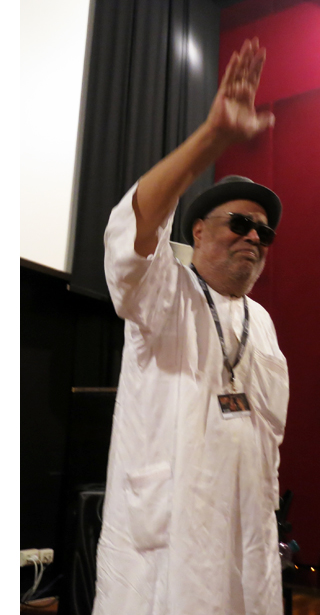 My first thought is, why do such recent films need restoration? Answer: maybe they’re not as recent as they seem to me. My second thought is, haven’t the studios realized that they need to take care of their films? Answer: Yes, to some extent, given the vital work done by studio archivists like Grover Crisp and Shawn Belston. Still, will There Will Be Blood be neglected until it needs restoration in twenty years’ time?
My first thought is, why do such recent films need restoration? Answer: maybe they’re not as recent as they seem to me. My second thought is, haven’t the studios realized that they need to take care of their films? Answer: Yes, to some extent, given the vital work done by studio archivists like Grover Crisp and Shawn Belston. Still, will There Will Be Blood be neglected until it needs restoration in twenty years’ time?
Among the relatively recent films presented in restoration here is Med Hondo’s West Indies (1979). The Film Foundation’s World Cinema Project undertook to restore a number of films by Hondo, a Mauritanian actor and director and one of the most important directors from the African continent.
West Indies is a remarkable film, a musical on the history of French slave-owning in its Caribbean colonies. Inside an empty factory Hondo built a large set depicting the upper and lower decks of a slave ship. The various sections of this ship provide stages upon which scenes, anything from a 1968 demonstration in the streets of Paris to a slave auction hundreds of years before. Five actors representing colonial interests, including a black man who cooperates in order to maintain his position as a figurehead governor, take similar roles throughout the action.
It’s a lively, entertaining film, done in color and widescreen, as well as a maddening look at French complacency and casual cruelty. Most of the musical numbers are dances rather than songs, with Hondo himself having choreographed several of them.
Hondo, now 81 and reportedly seeking backing for another film, was present at the festival and introduced the screening of West Indies that we attended. He was visibly moved by the chance to show this little-known work to an appreciative audience and thoroughly won us over during his brief presentation. With luck we will see a tenth film from him.
Thanks to Guy Borlée for his assistance with this blog, and to the programmers and staff of Ritrovato for another dazzling year. You can download the entire festival catalogue here.
Kelley Conway reviewed Visages Villages at Cannes for our blog.
Le coupable (1917)












